I came to Athens completely without any plan. My coming here was the desire of the higher powers that moved the departure from Heraklion and made me miss the flight from Athens to Belgrade. Then the air-carrier put me in a hotel that turned out to be in the centre of the city and with a lot of luck I agreed a return flight for the afternoon. This gave me a whole morning in Athens.
The hotel accommodation also included breakfast, but I did not enjoy it since I woke up with headache. It seems that the previous day was far too stressful for me after all, although I seemed quite calm. After the breakfast I went up to the top of the hotel from where I had a splendid view at Athens, as well as Acropolis.
 Athens, Acropolis is in the distance, in the middle
Athens, Acropolis is in the distance, in the middle
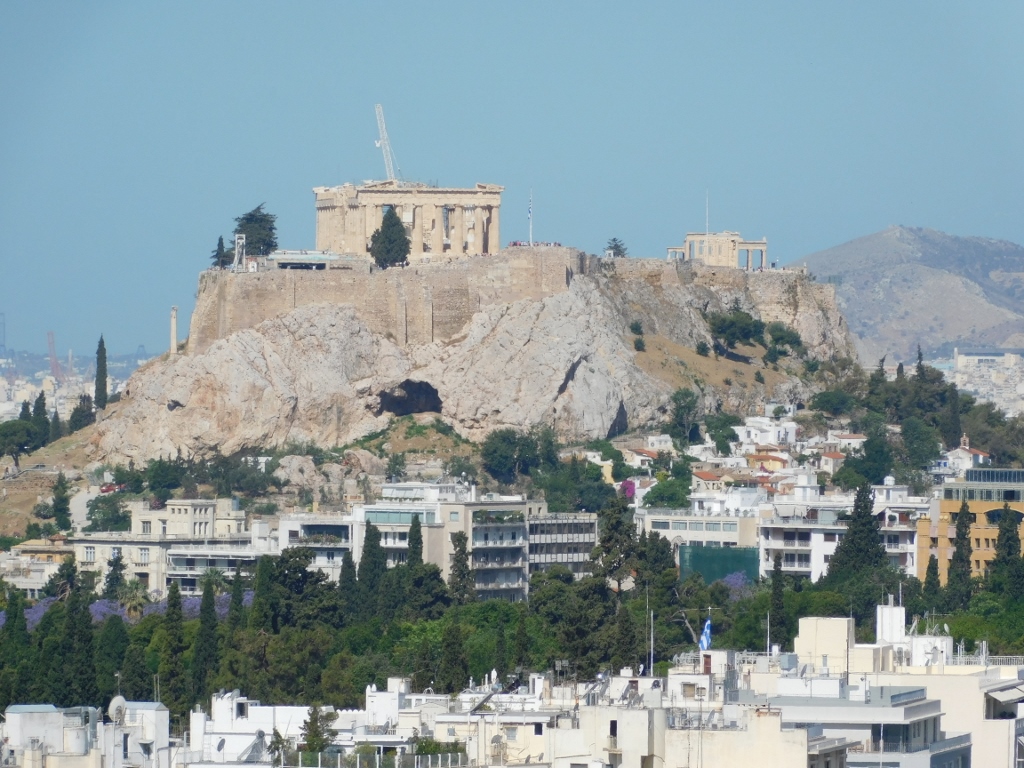 Zoomed in Acropolis
Zoomed in Acropolis
At some point the headache somehow disappeared and I checked out of the hotel, while leaving my things at the reception. I had full three hours and I used them to walk to Acropolis and visit it again after many, many years.
The first time I was in Athens was a long time ago. I went with my friend Vesna to spend some time there around the New Year’s Day. The two of us did visit a lot of places, but there is so much to see in Athens, including also some important museums. At the time Vesna and I went to visit Acropolis, but although little has changed there, I decided to go again this time around in order to revisit the place that is so important for the European, as well as the world civilisation and culture.
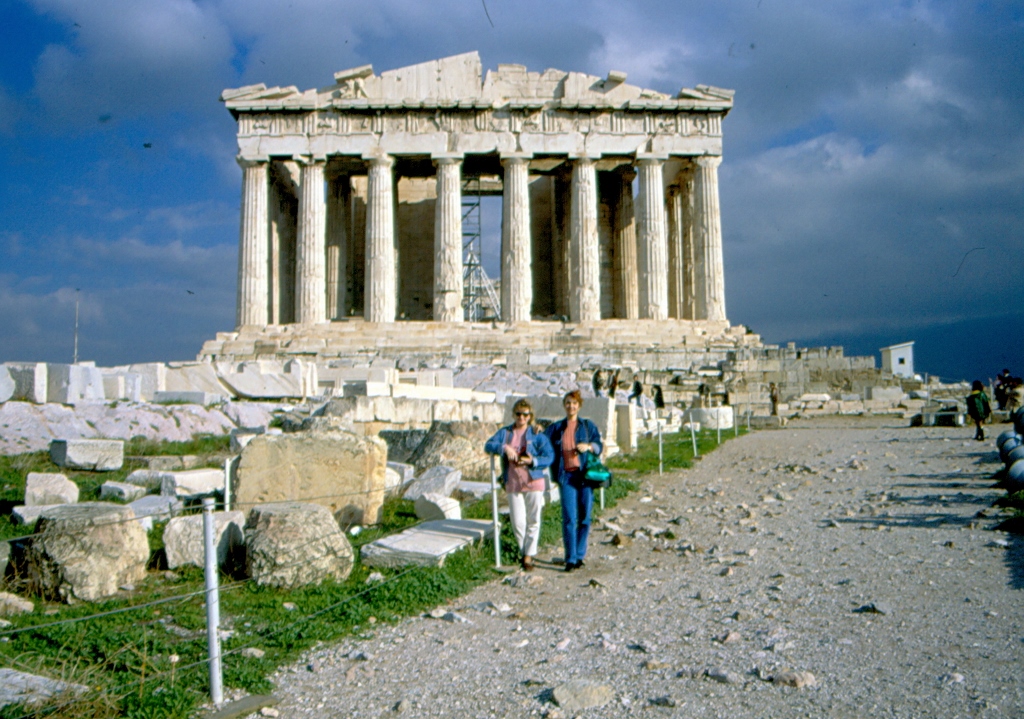 In Acropolis with Vesna many years ago
In Acropolis with Vesna many years ago
Now, at the end of May 2022, I set on foot from the hotel towards Acropolis passing through the rather green streets of Athens along the way.
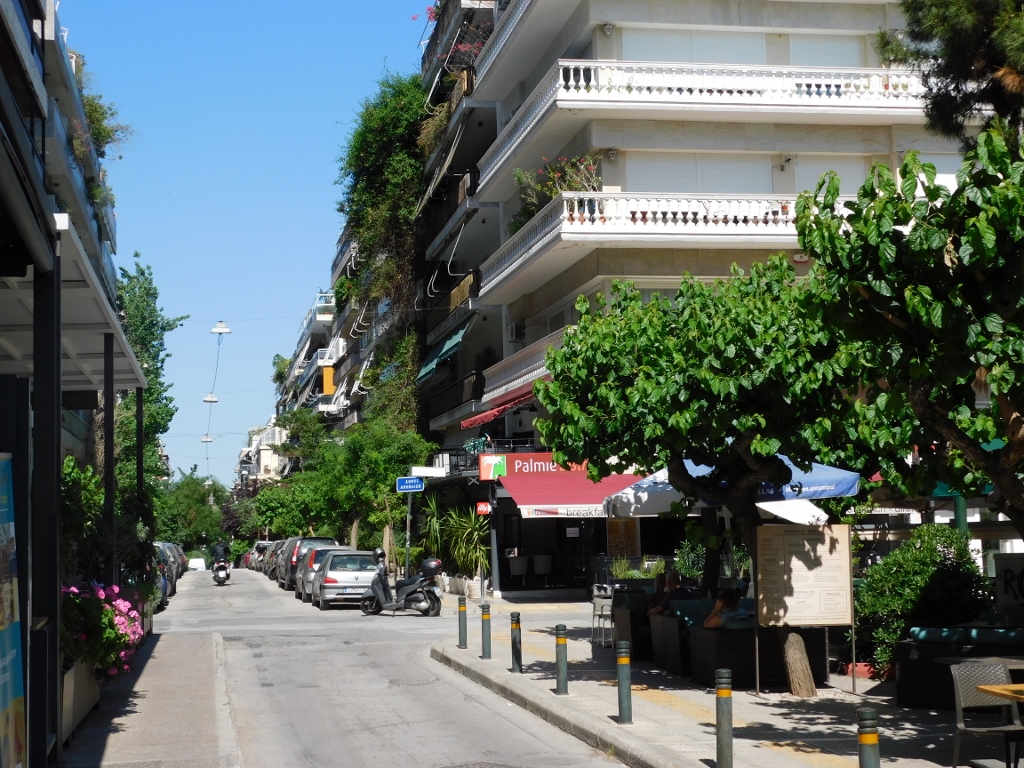 Athens, a detail
Athens, a detail
After some 15-20 minutes of walk, I reached the Panathenaic Stadium, also called Kallimarmaro. This is the stadium where the first modern Olympics was organised in 1896. It was made by actually reconstructing remains of an ancient stadium from the 2nd century CE. This is the only stadium in the world that is fully made of marble, which its nickname also suggests – Kallimarmaro means “beautiful marble.”
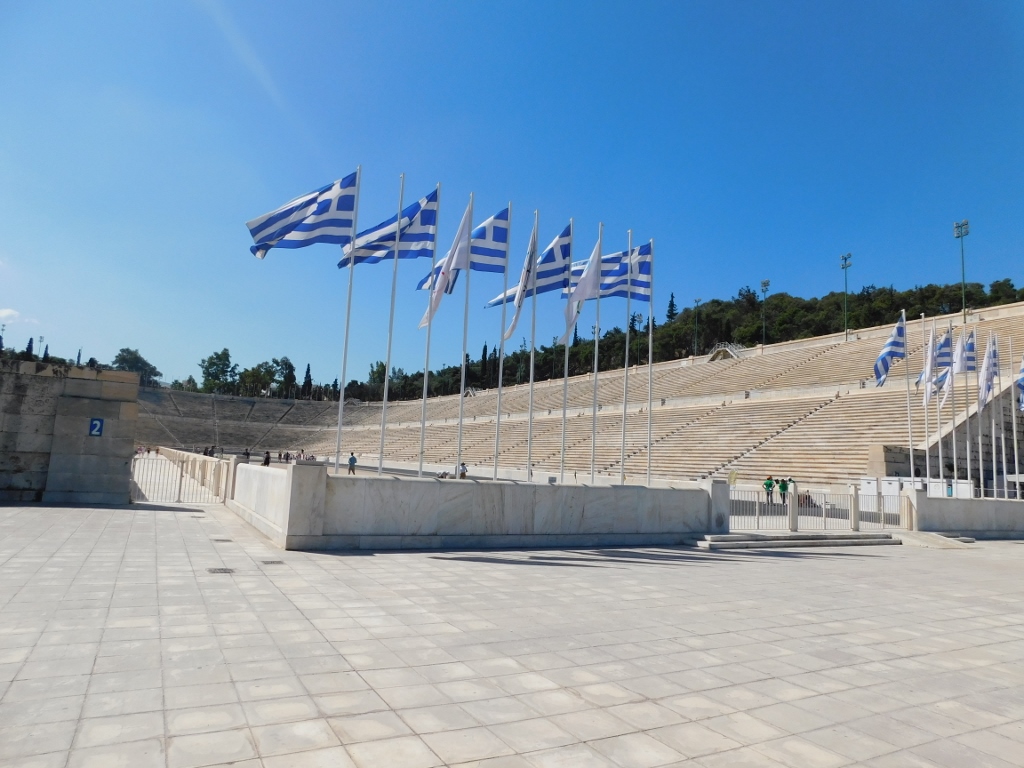 Panathenaic Stadium
Panathenaic Stadium
Needless to say, I did not have the time to visit the stadium, so I just continued with my walk that soon took me by the Zappeion Gardens and Hall. This building was made at the end of the 19th century for the needs of the 1896 Olympics and is nowadays used for meetings and ceremonies, both official and private.
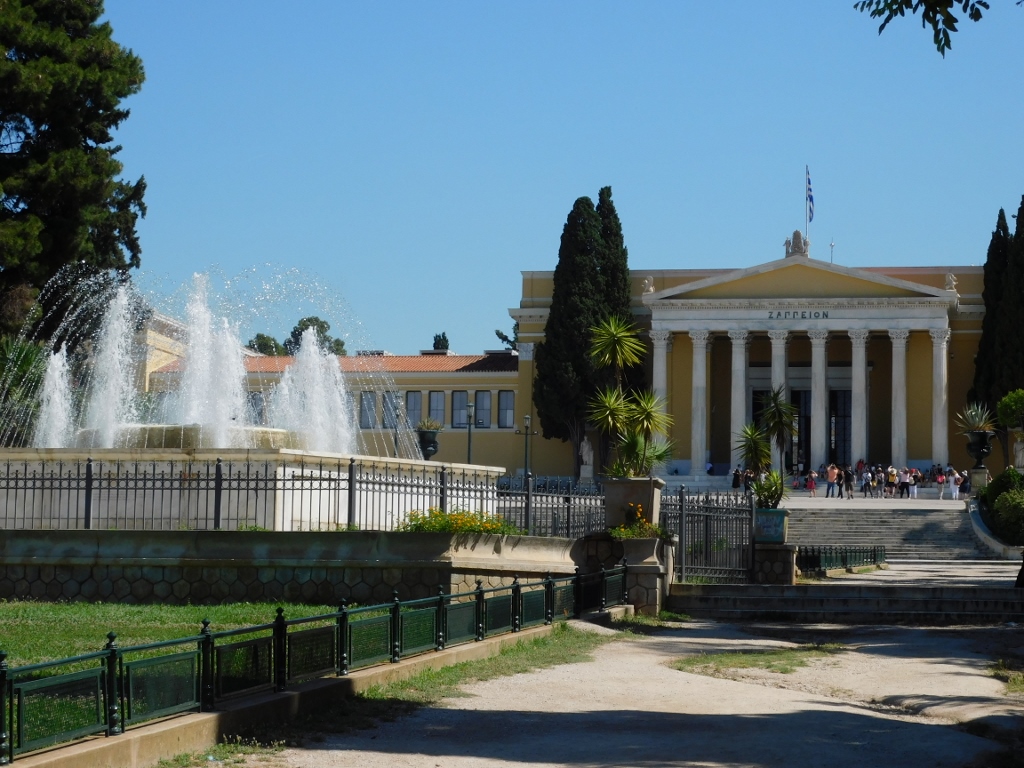 Zappeion Gardens and Hall
Zappeion Gardens and Hall
South of the Zappeion Gardens there is an area where remains of numerous temples may be seen. The most striking and the most important one is the Temple of Olympian Zeus the construction of which started in the 6th century BCE and was completed in the 2nd century CE during the reign of Roman Emperor Hadrian.
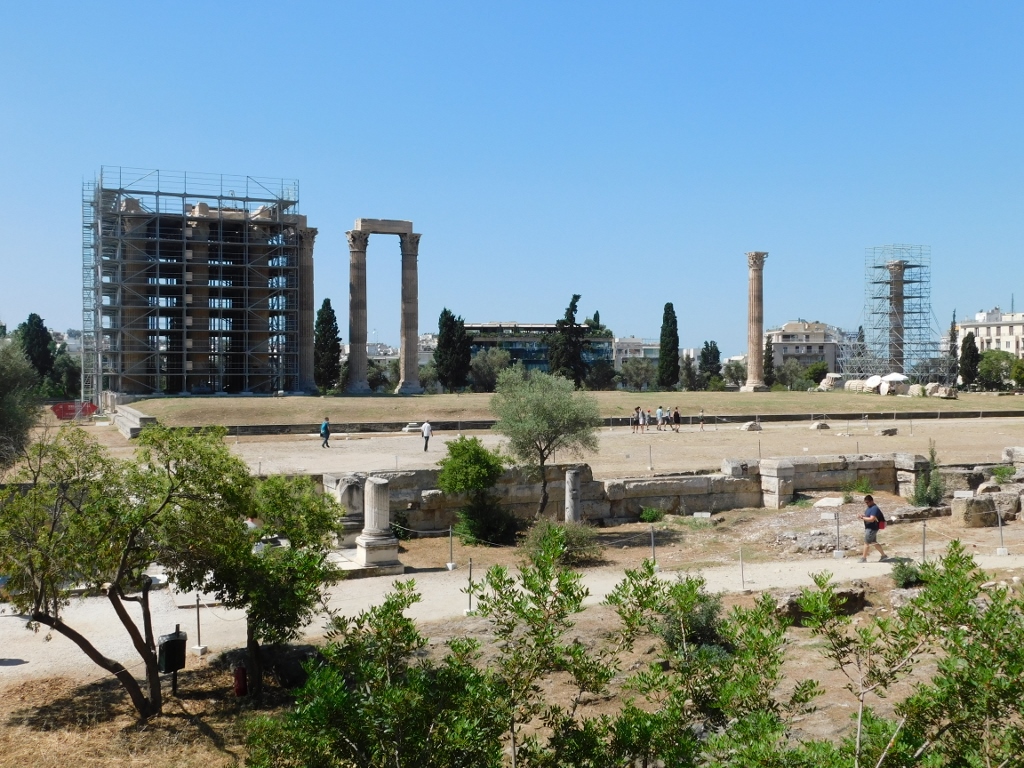 Remains of ancient buildings: the columns of the Temple of Olympian Zeus are covered in scaffolding
Remains of ancient buildings: the columns of the Temple of Olympian Zeus are covered in scaffolding
Since I’m mentioning Hadrian, not far from here, beside a street that is probably constantly jammed by traffic, there is the Arch of Hadrian made of marble in the 2nd century CE. It is not clear who exactly made this arch, but an inscription on it expresses respect for Hadrian and hence the name.
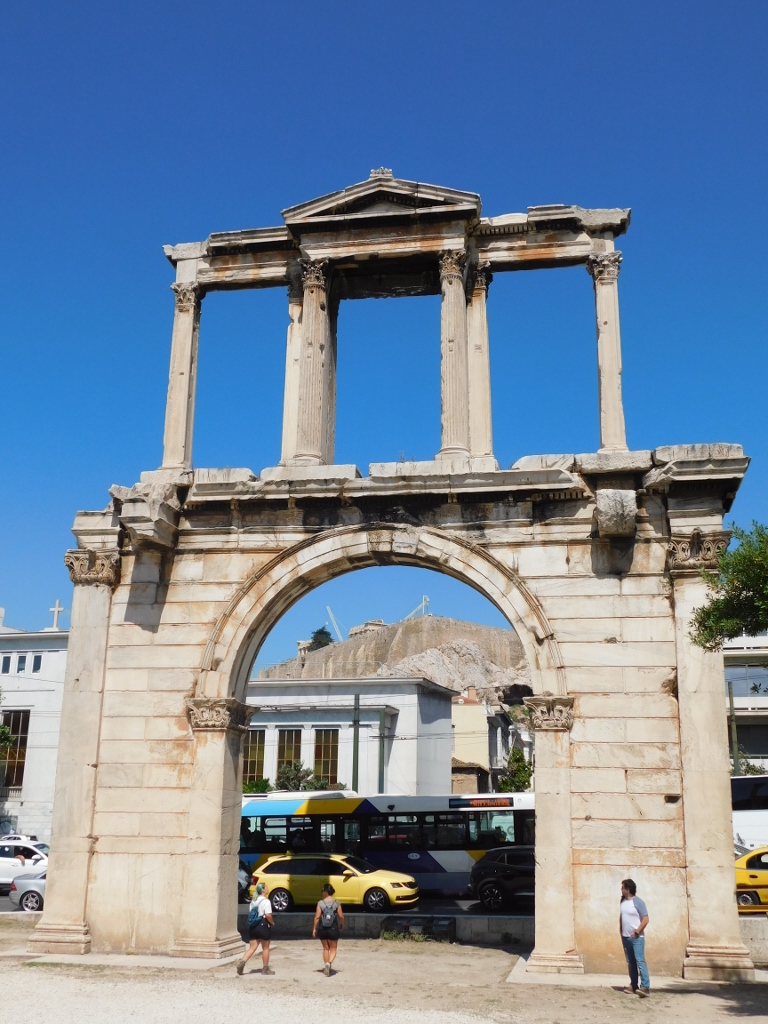 Arch of Hadrian
Arch of Hadrian
Several hundred metres farther, there is an entrance to the Acropolis of Athens.
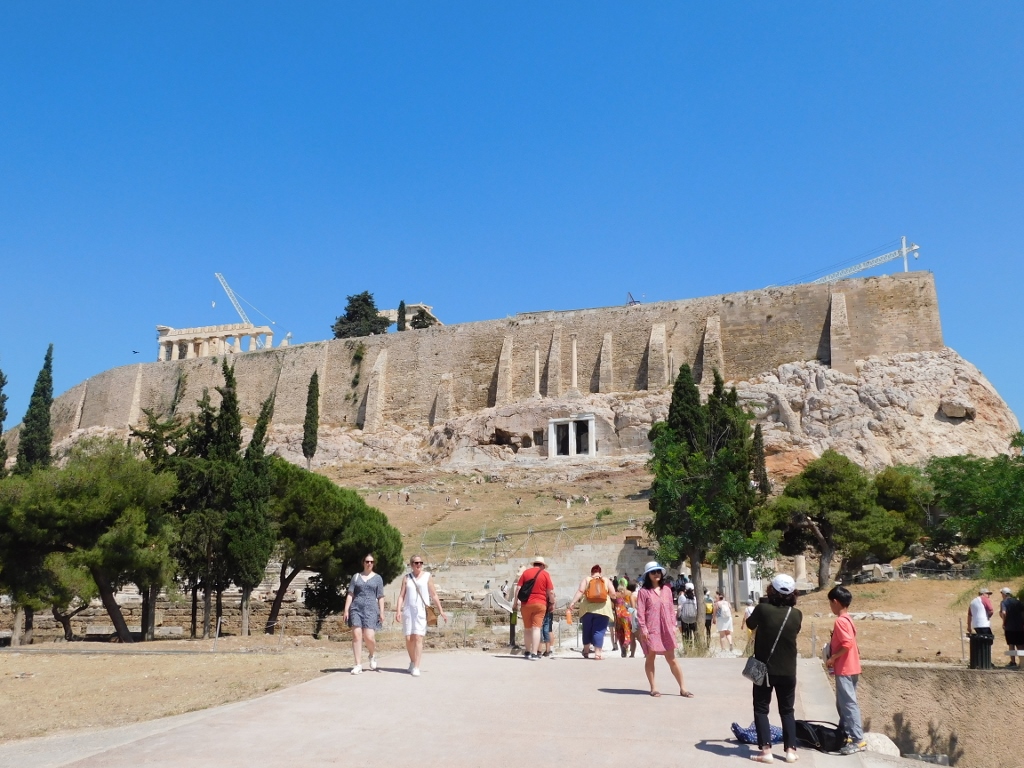 Acropolis of Athens
Acropolis of Athens
This is an ancient citadel built on a rocky hillock above Athens and several important ancient buildings can be seen here today. The very word “acropolis” used nowadays as a technical term for parts of various ancient settlements comes from Greek and actually means “the city on the highest point.”
I will not go into any general details concerning ancient Greece now, but will only deal with the structures within the Acropolis of Athens that I visited on this occasion. First I went to the Theatre of Dionysus.
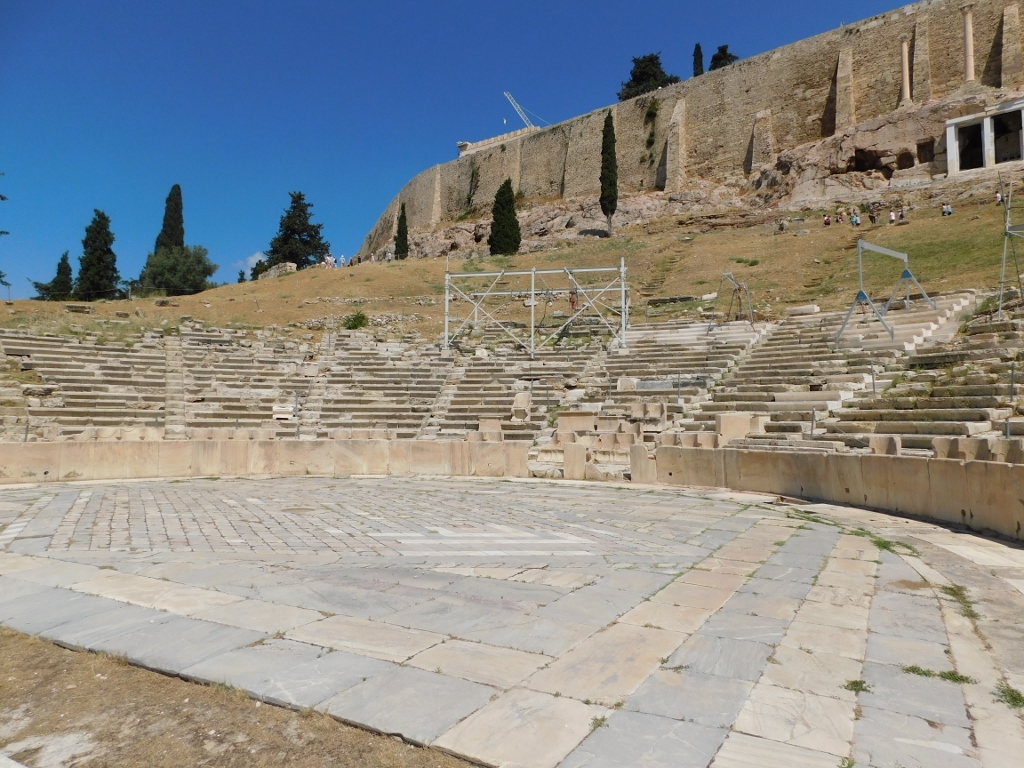 Theatre of Dionysus
Theatre of Dionysus
Dionysus was the ancient Greek god of fertility and wine, as well as religious ecstasy and theatre. At the site where the Theatre of Dionysus at the Acropolis is located, special celebrations dedicated to this god were organised back in the 6th century and already at the beginning of the 5th century the first theatre was made which incorporated wooden terraces for the spectators. The stone theatre was built in the 4th century BCE and among other things it included between 17,000 and 19,000 seats distributed in an arch around the circular orchestra.
The archaeological site of the Acropolis and the remains of numerous structures may certainly be visited for hours, but I did not have that much time, so I just dealt with the most important ones. Thus I just walked past the Stoa of Eumenes. In the ancient Greek architecture, stoa is the term for a long portico that has only one longer side open.
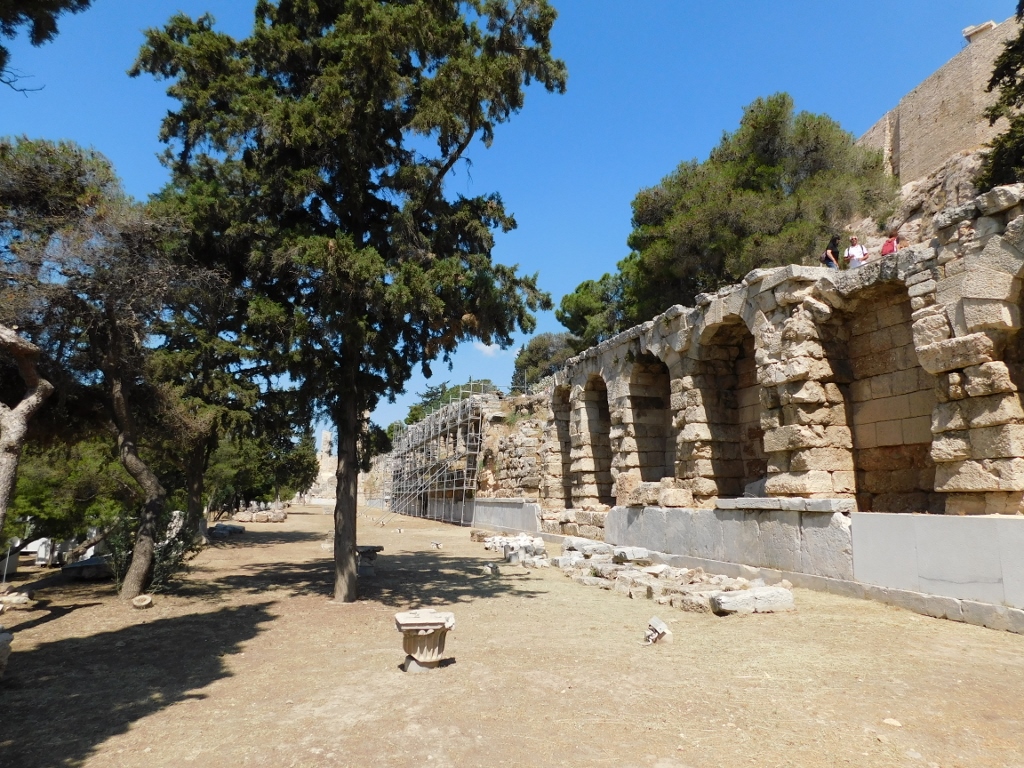 Beginning of the Stoa of Eumenes
Beginning of the Stoa of Eumenes
I also just passed the Asklepieion, a temple dedicated to the god of medicine Asklepios. By the way, his daughter was Hygieia who gave the name to the term “hygiene.”
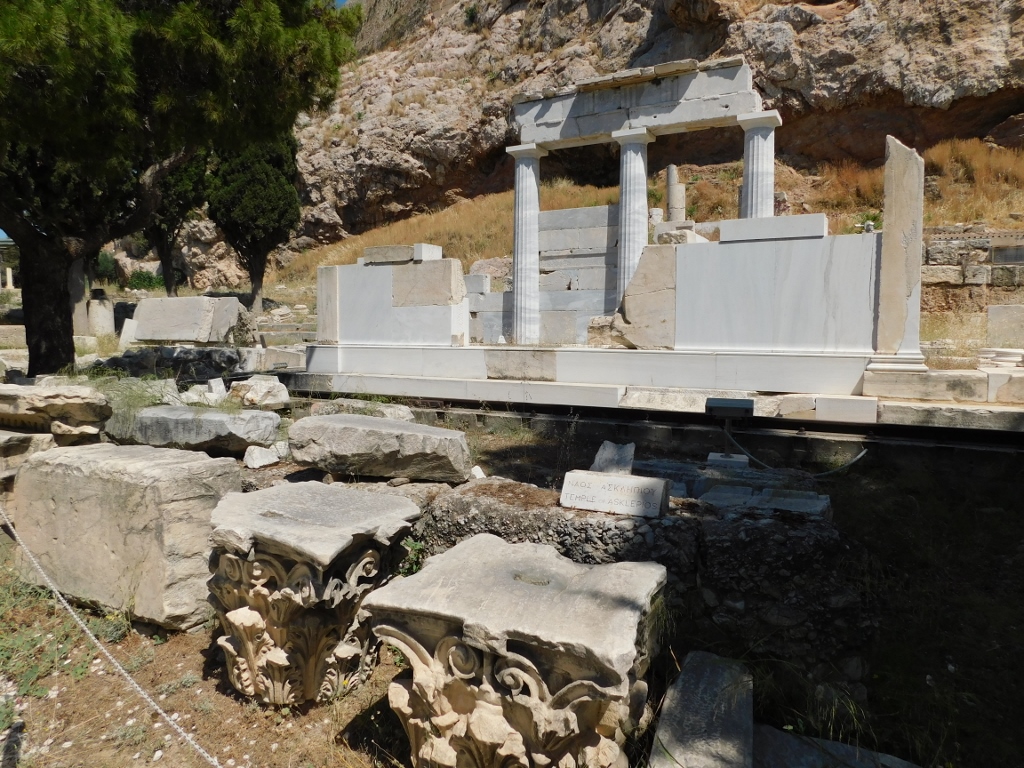 Asklepieion
Asklepieion
By the way, here I followed a pathway called Peripatos. The names of pathways are usually not very important, but the term “peripatos” meaning walkway can be found in the name of the school and disciples of the famous philosopher Aristotle (384-322 BCE) – the Peripatetic School and Peripatetics. It is important to say that the name of the school of philosophy was not given after this pathway at the Acropolis, but after the pathways of the Lyceum of Aristotle the remains of which have been found some 2.5 km further away.
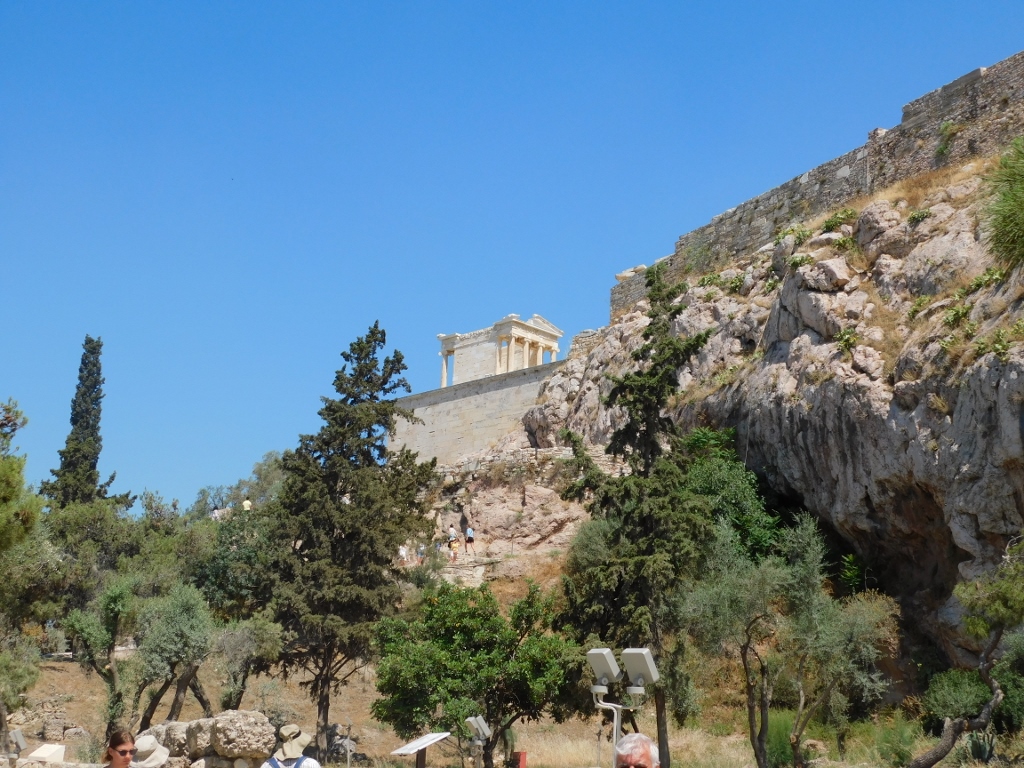 View at the Acropolis from pathway Peripatos
View at the Acropolis from pathway Peripatos
The next structure at the foot of the Acropolis that I reached during my visit, that is, which I saw from up high, was the Odeon of Heron Atticus.
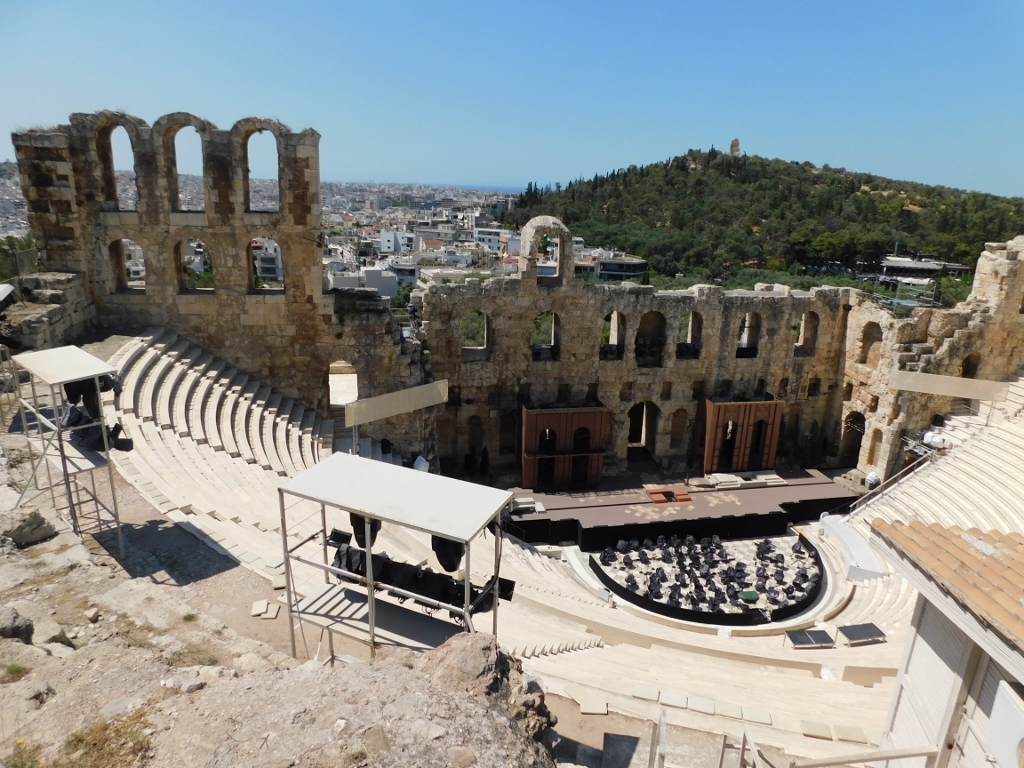 Odeon of Heron Atticus
Odeon of Heron Atticus
The construction of this stone theatre that can receive between 5000 and 6000 spectators was completed in 161 BCE and it was built by Heron Atticus in memory of his wife Appia Annia Regilla. The theatre was restored in 1950 and as it may be seen in the photographs, it has found its use nowadays mostly as the main venue of the Athens Festival. More or less everybody who is anybody in the world of music, at the world level, has had their concerts here.
 Odeon of Heron Atticus
Odeon of Heron Atticus
From here, the pathway continues to ascend towards the top of the Acropolis and leads to the Propylaia, but first I looked around. To the northwest, at the foot of the Acropolis, there is a spacious park filled with remains of ancient buildings. This is the Ancient Agora of Athens – today an archaeological site and at the time of ancient Greece and Rome the centre of Athens. The most visible within the site is the Temple of Hephaestus which represents the best preserved temple in Greece from the period of antiquity. By the way, Hephaestus was the god of fire and blacksmithing, as well as volcanoes.
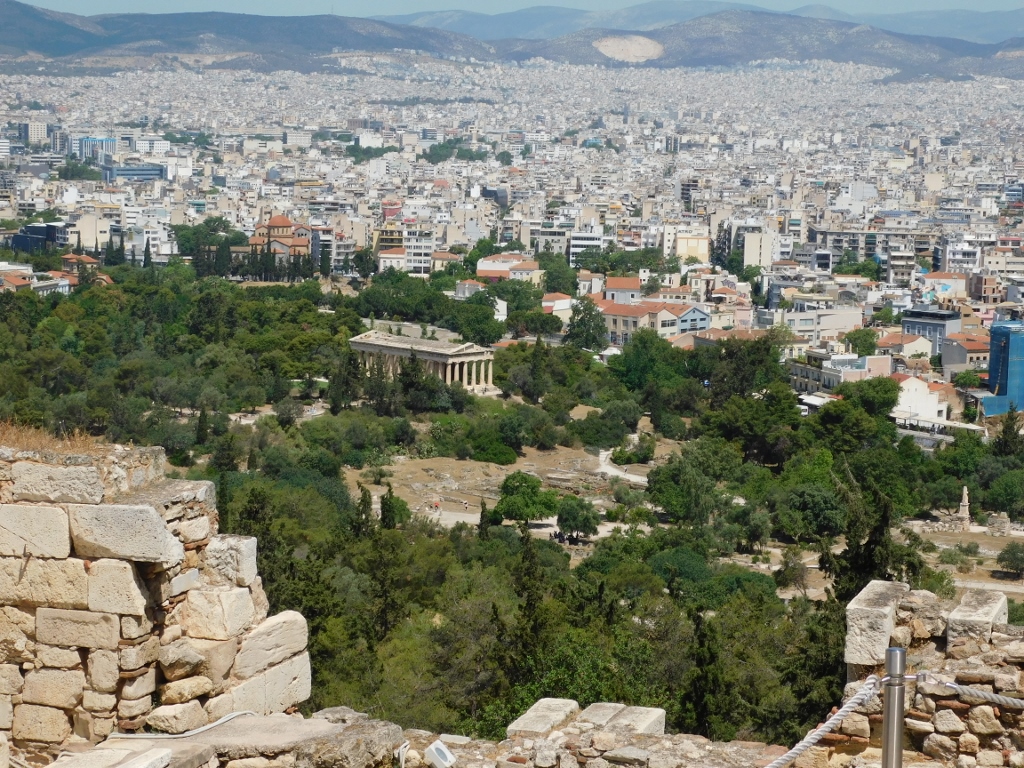 View at the Ancient Agora of Athens
View at the Ancient Agora of Athens
I also looked carefully at the staircase I was climbing, thinking of the millions of people who have walked here. I don’t know if the steps are the originals and then only repaired over time, but I liked imagining that this is where Plato and Aristotle walked, as well as Phidias and Pericles.
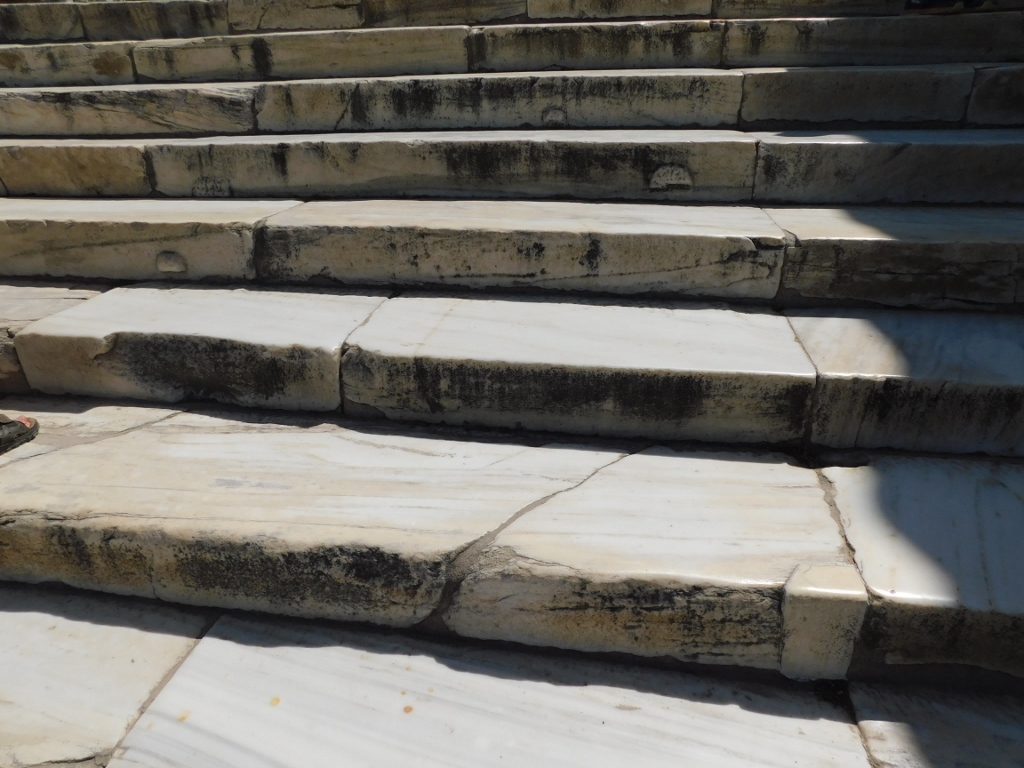 Steps in front of the Propylaia of the Acropolis of Athens
Steps in front of the Propylaia of the Acropolis of Athens
The propylaeum is a term used in architecture to denominate a monumental ceremonial access to a temple. However, the name of this one at the Acropolis of Athens is spelt Propylaia.
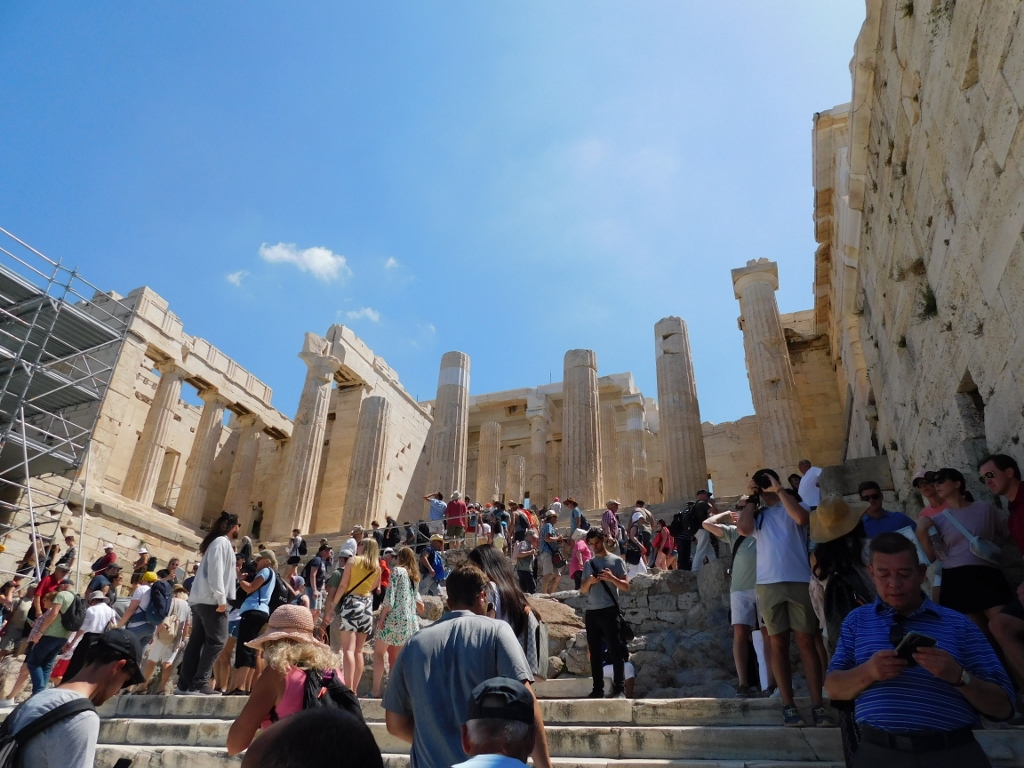 Access to the Propylaia of the Acropolis of Athens
Access to the Propylaia of the Acropolis of Athens
This one at the Acropolis of Athens was built on the west slope of the elevation in 437-432 BCE, but because of the outbreak of the Peloponnesian War it remained unfinished. The structure is particularly monumental and complex: it consists of a central part and two flanking wings, while some parts originally had painted decorations. The columns in front of the porches of the central building and the flanking wings were made in the Doric style, while the columns in the interior section of the Propylaia are of the Ionic order.
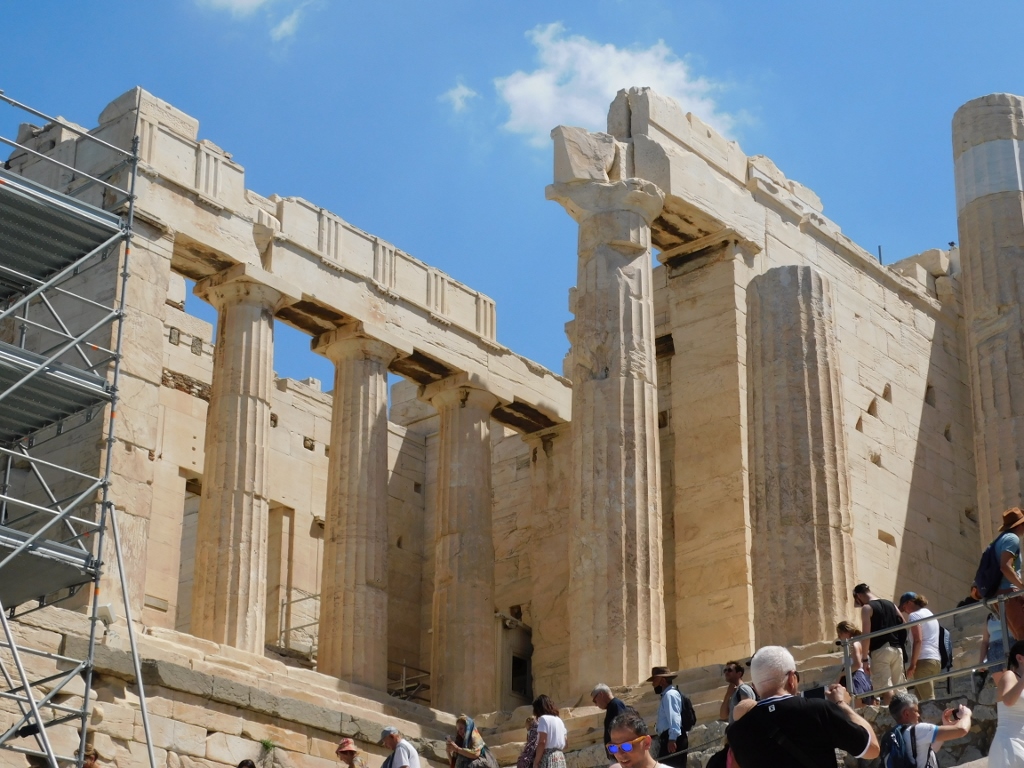 Propylaia of the Acropolis of Athens, a detail
Propylaia of the Acropolis of Athens, a detail
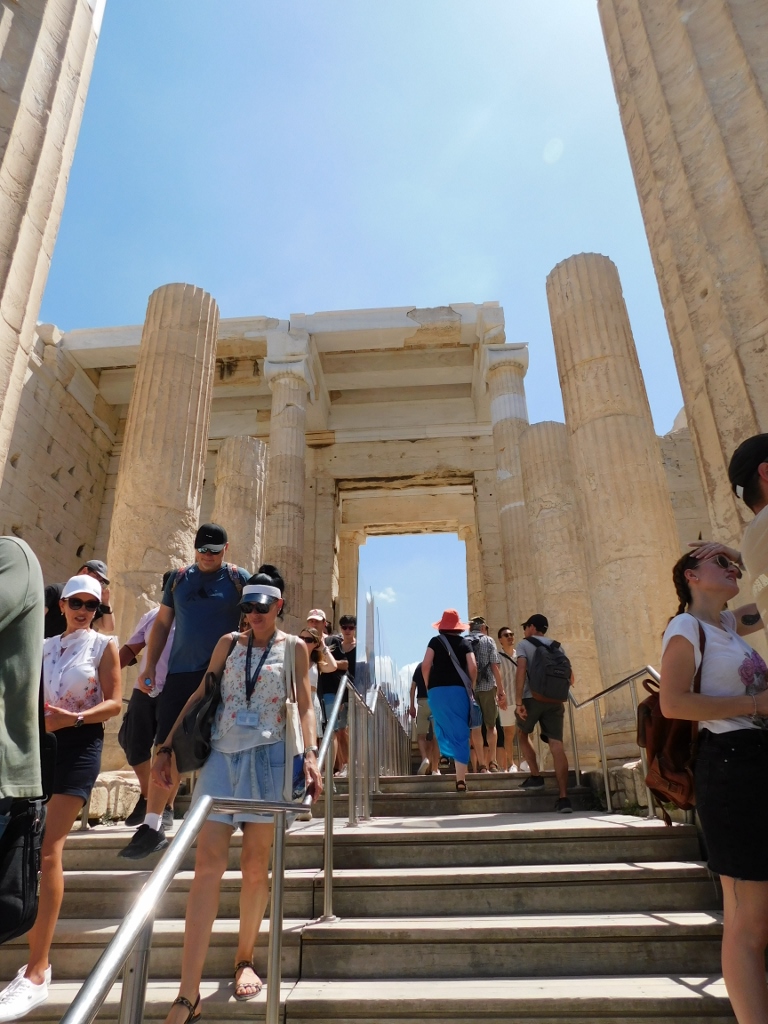 Propylaia of the Acropolis of Athens, a detail
Propylaia of the Acropolis of Athens, a detail
In the 6th century CE, the south wing was turned into a Christian basilica. In the Middle Ages, European rulers turned the entire Propylaia into a palace, while a high tower was built in the south wing. Later, the Ottomans strengthened the fortification by adding a bastion. In 1640, when Athens was firmly ruled by the Ottomans, there was an explosion of the gunpowder kept in the building and the whole complex was significantly damaged. During the excavations of the Acropolis in the 19th century, the medieval and subsequent additions were removed in order to reveal the Propylaia of the Classical period.
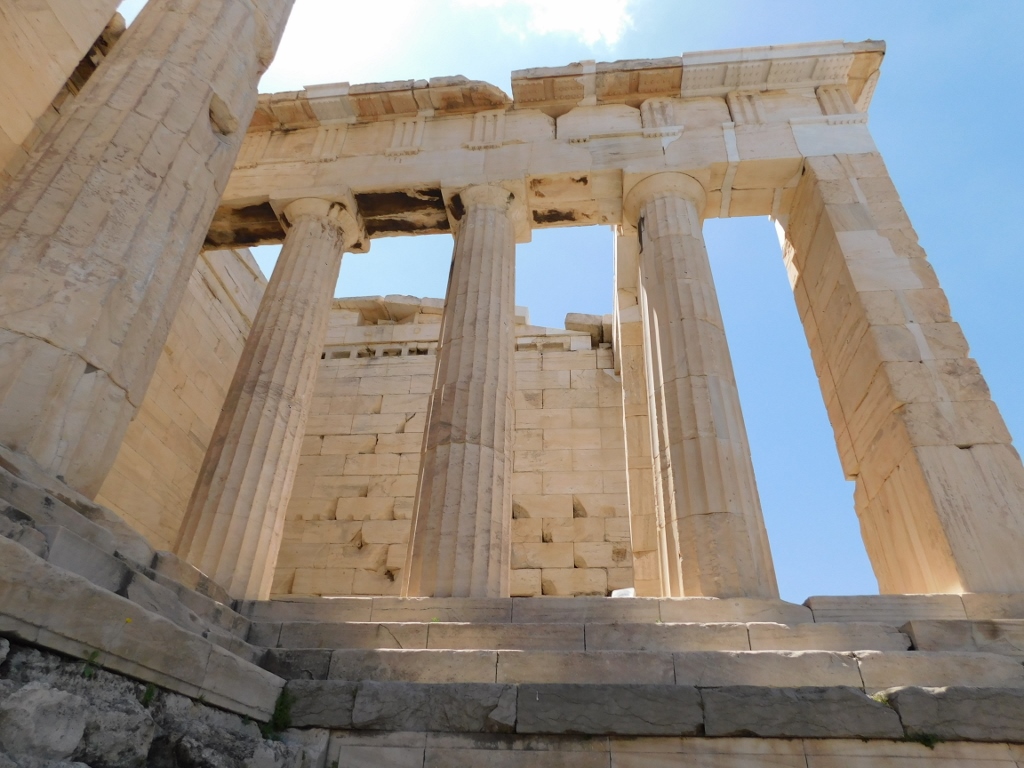 Propylaia of the Acropolis of Athens, view at a part of the south wing
Propylaia of the Acropolis of Athens, view at a part of the south wing
West of the south wing, on a platform that stands above the slope of the hillock, there is a smallish, but exceptionally lovely Temple of Athena Nike.
 View from the staircase of the Propylaia with the Temple of Athena Nike
View from the staircase of the Propylaia with the Temple of Athena Nike
The temple is closed to public and this is in fact the reconstruction of the original temple built at this site. This is a small structure (8.3 x 5.4 m) with Ionic columns and its construction was completed in 420 BCE. Athena and Nike were in fact two goddesses, but in this case, Athena had the essence of Nike added to her, since the latter was the goddess of victory, and thus this is a temple dedicated to victorious goddess Athena.
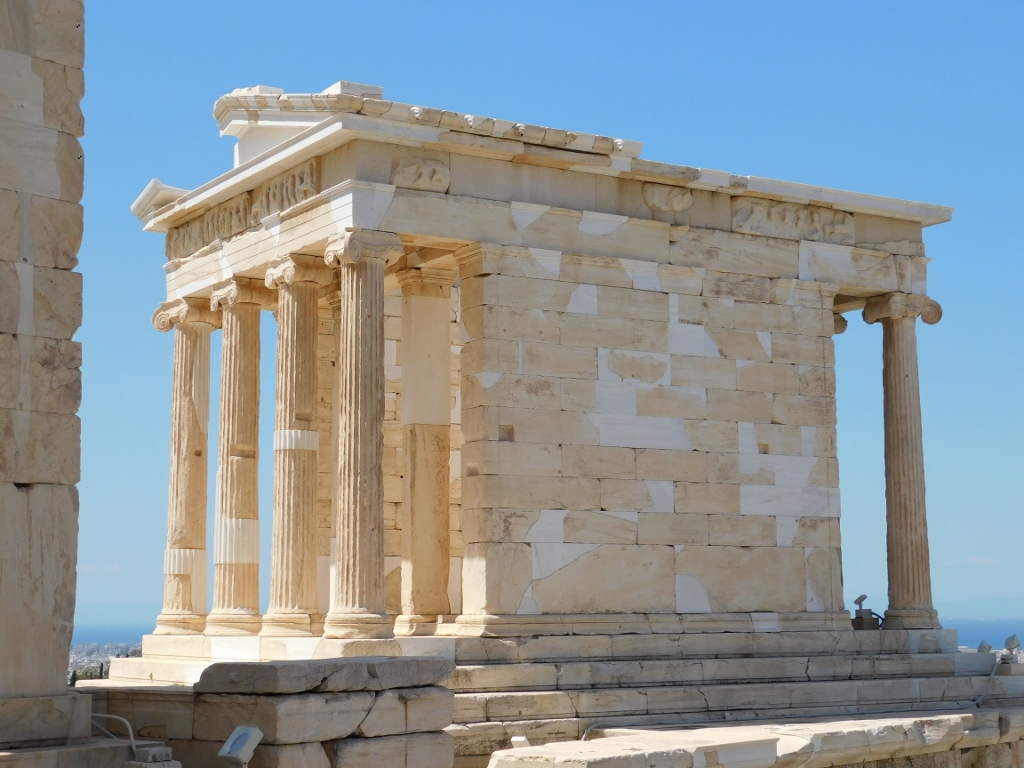 Temple of Athena Nike
Temple of Athena Nike
Nowadays, the visitors go through the Propylaia following clearly set pathways and before leaving the structure you can see nicely the Doric columns that also decorate the east portico, as well as the impressive ceiling.
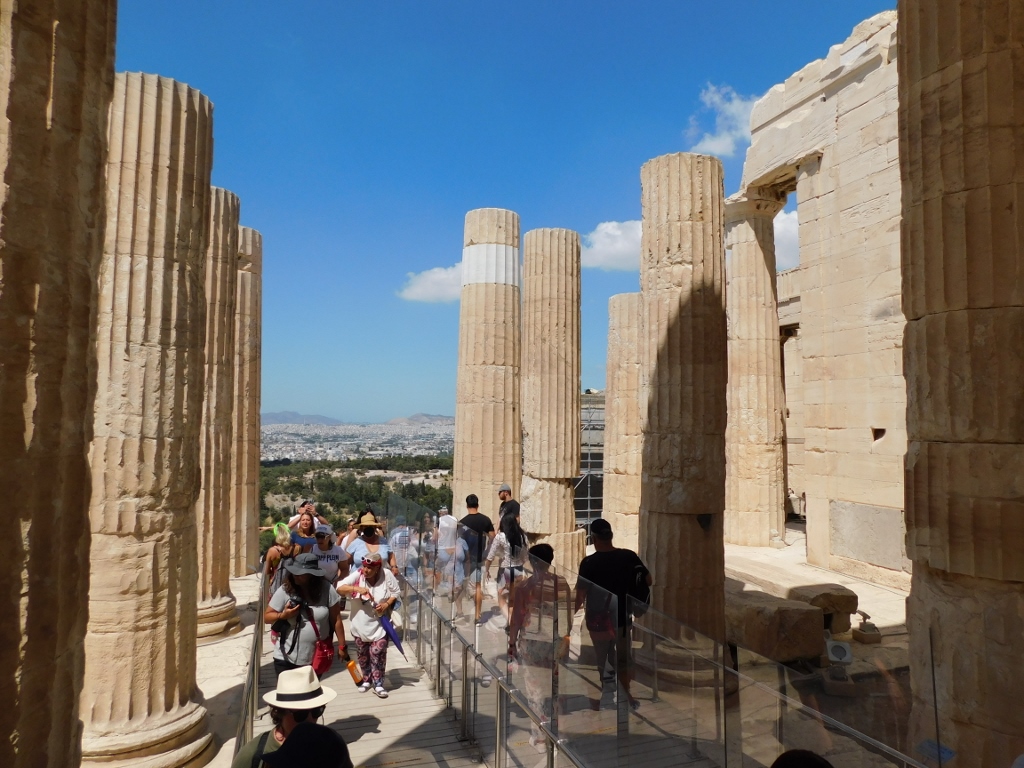 Propylaia of the Acropolis of Athens, a detail
Propylaia of the Acropolis of Athens, a detail
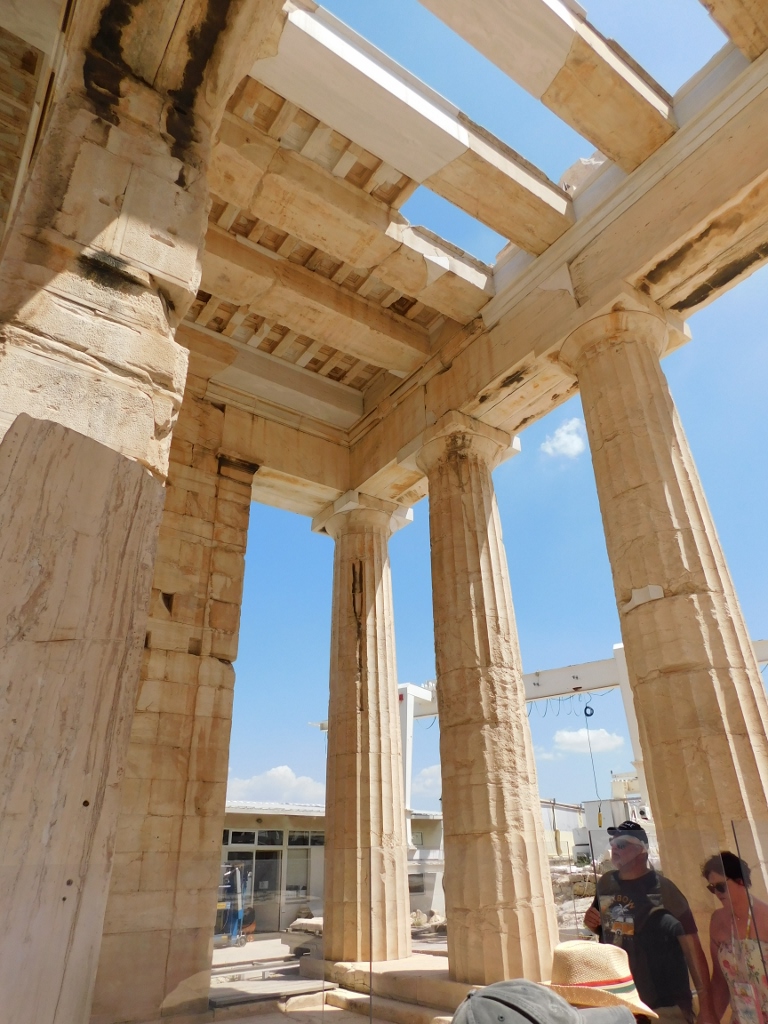 Propylaia of the Acropolis of Athens, a detail
Propylaia of the Acropolis of Athens, a detail
Still, in my mind the most impressive view at this ancient building is when you leave it and then look back at the east “facade.” Only here can you grasp the true beauty of this building and try to imagine how striking it must have been when first built.
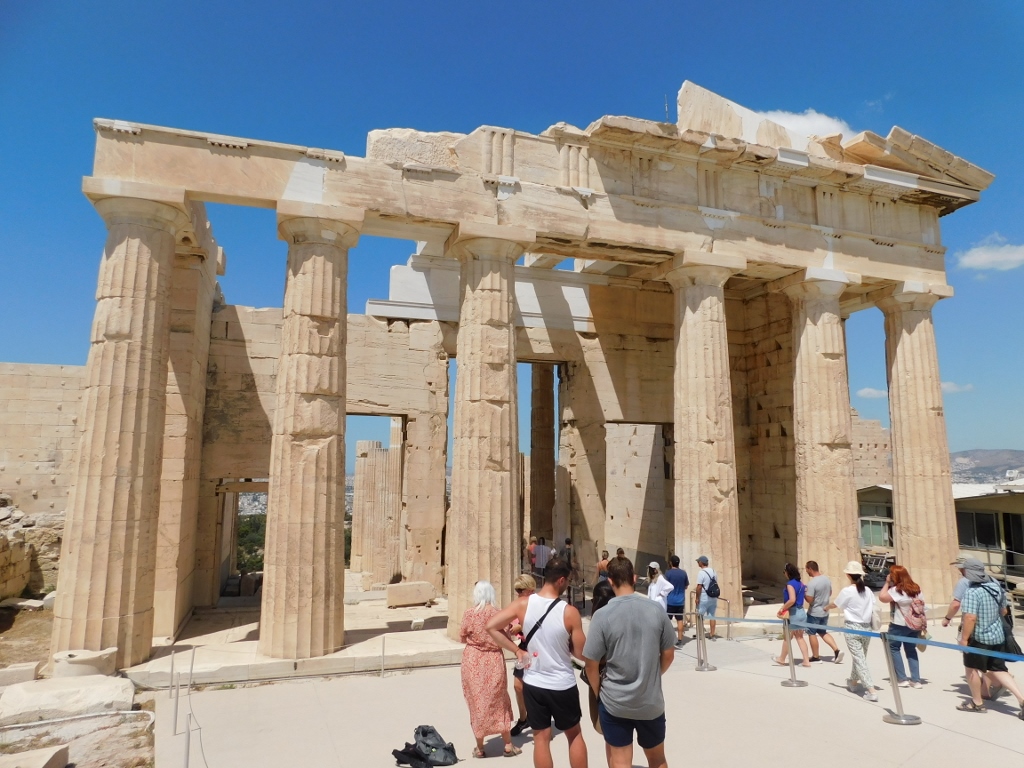 Propylaia of the Acropolis of Athens
Propylaia of the Acropolis of Athens
And when you walk towards the south side of the Propylaia you can then see the Temple of Athena Nike and its elegant Ionic columns that peer lovely from around a corner.
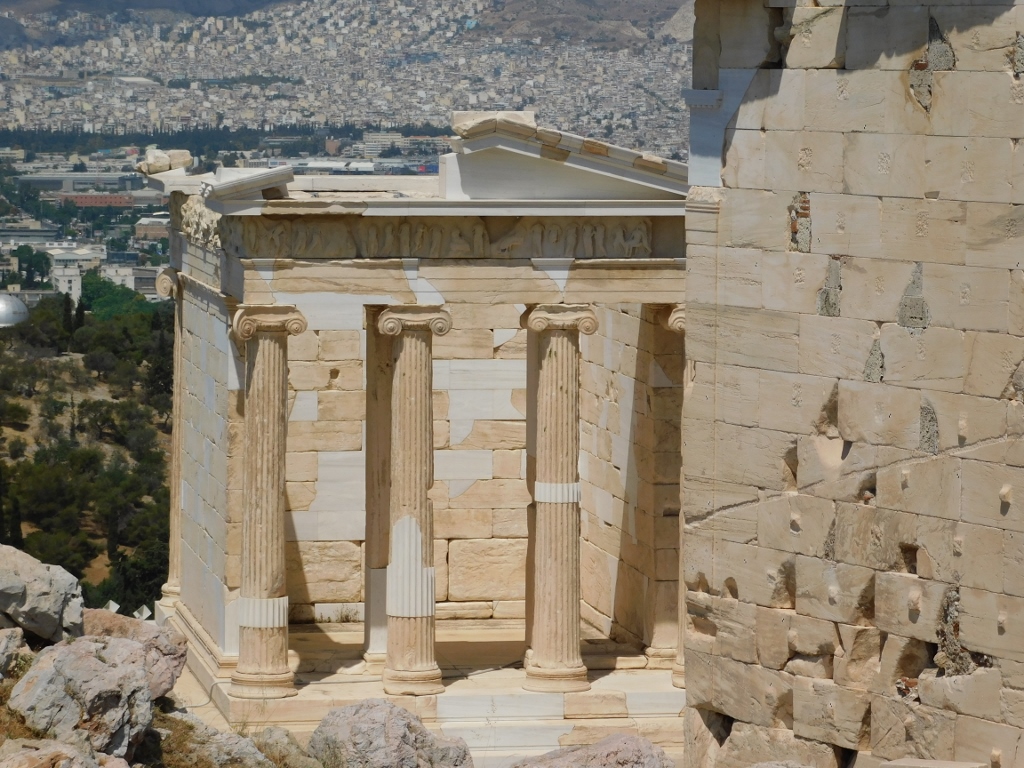 Temple of Athena Nike
Temple of Athena Nike
When leaving the Propylaia, the visitor has practically reached the top of the Acropolis where formally speaking there are only a few other minor elevations, but this is negligible. On the left-hand side one can see the Erechtheion and on the right-hand side the Parthenon.
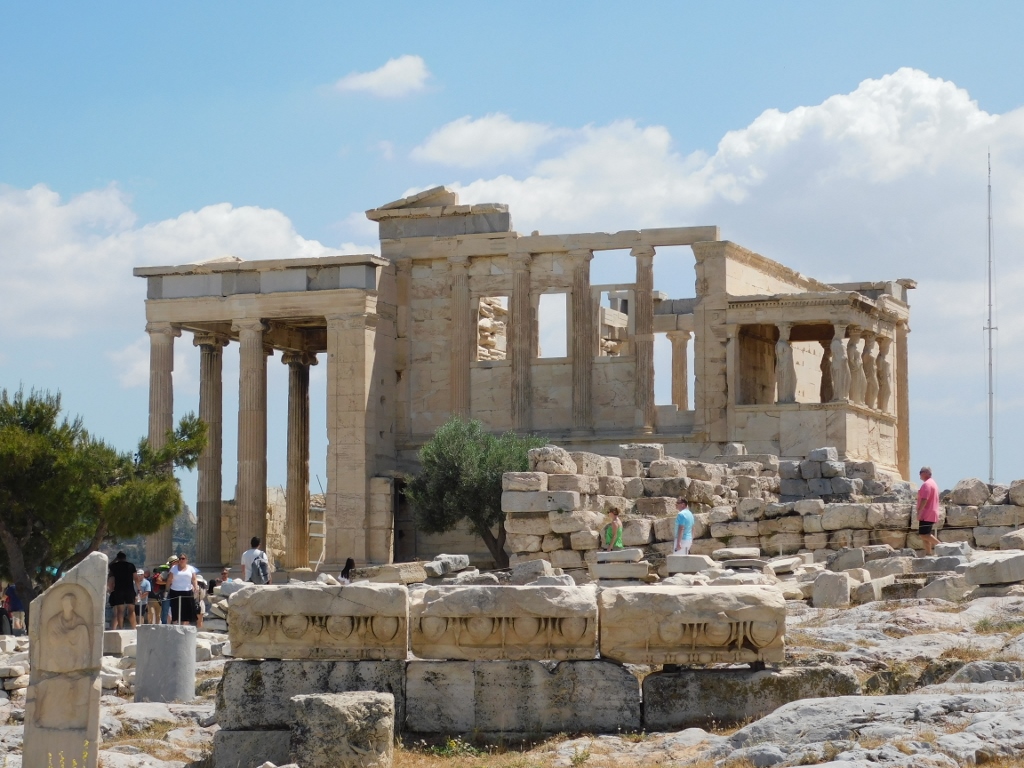 Erechtheion
Erechtheion
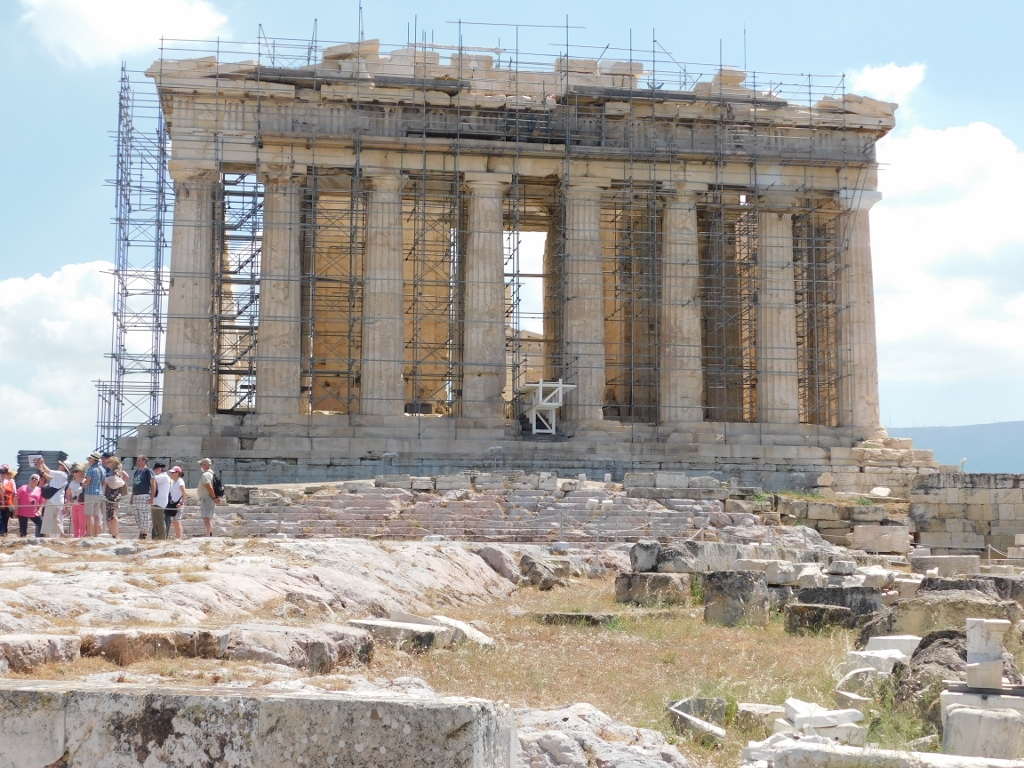 Parthenon, the front, west side
Parthenon, the front, west side
I first went to make a circle around the Parthenon, but along the way from the terrace on the south side of the Acropolis I took some photos of the south parts of Athens, while in the distance I could see the blue waters of the Aegean Sea.
 South parts of Athens
South parts of Athens
As for the Parthenon, it was made of marble in the period from 447 to 432 BCE at the site where earlier there had been a stone temple which the Persians destroyed in 480 BCE. This was at the time when Athens was ruled by the famous ancient Greek statesman and military commander Pericles (around 495-429 BCE). In addition to being involved in politics and ruling, Pericles was also a great lover of arts and sciences, and thanks to his passion towards beautiful things the world received – the Parthenon. Namely, the period of Pericles’s rule (461-429 BCE) is called the Golden Age of Athens which at that time was the centre of culture and spirituality of the ancient world.
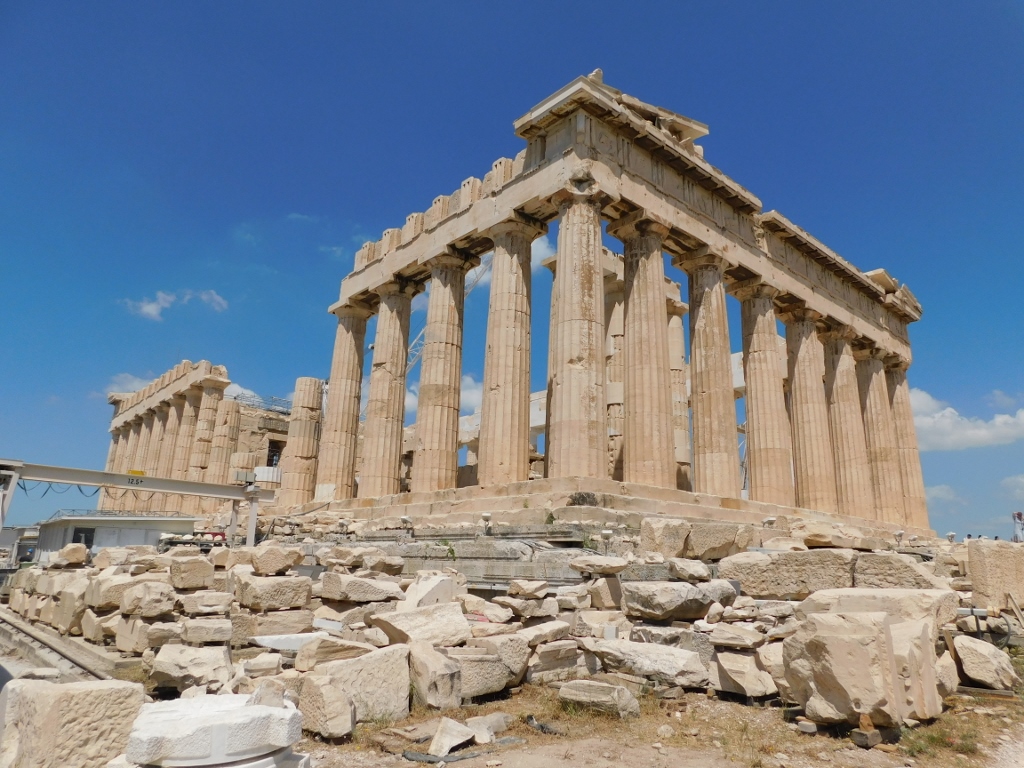 Parthenon, the southeast side
Parthenon, the southeast side
A friend of Pericles and the chief adviser about all things linked to arts, including also sculpture and architecture, was Phidias (around 480-430 BCE), according to many the greatest sculptor of ancient Greece. He was the author of the Statue of Zeus at Olympia that was one of the Seven Wonders of the Ancient World. As a close friend of Pericles, he was here involved in the supervision of the works on the construction of the main temple on the Acropolis dedicated to Athena, the goddess of wisdom, handicraft and warfare who was also the protectress of the city named after her.
In addition to managing the works on the construction of the temple (he was practically the head of the construction site and the chief arts director), Phidias himself was the author of the monumental sculpture of goddess Athena that was placed within the Parthenon. Over time, all trace of her has been lost. This was the statue of Athena Parthenos, which means “Athena the virgin,” and the whole temple was named after her. Phidias was also the author of the colossal bronze statue of Athena Promahos that was placed here in the Acropolis, between the Propylaia and the Parthenon, and that was around 9 m tall. It was later transferred to Constantinople where it was eventually destroyed.
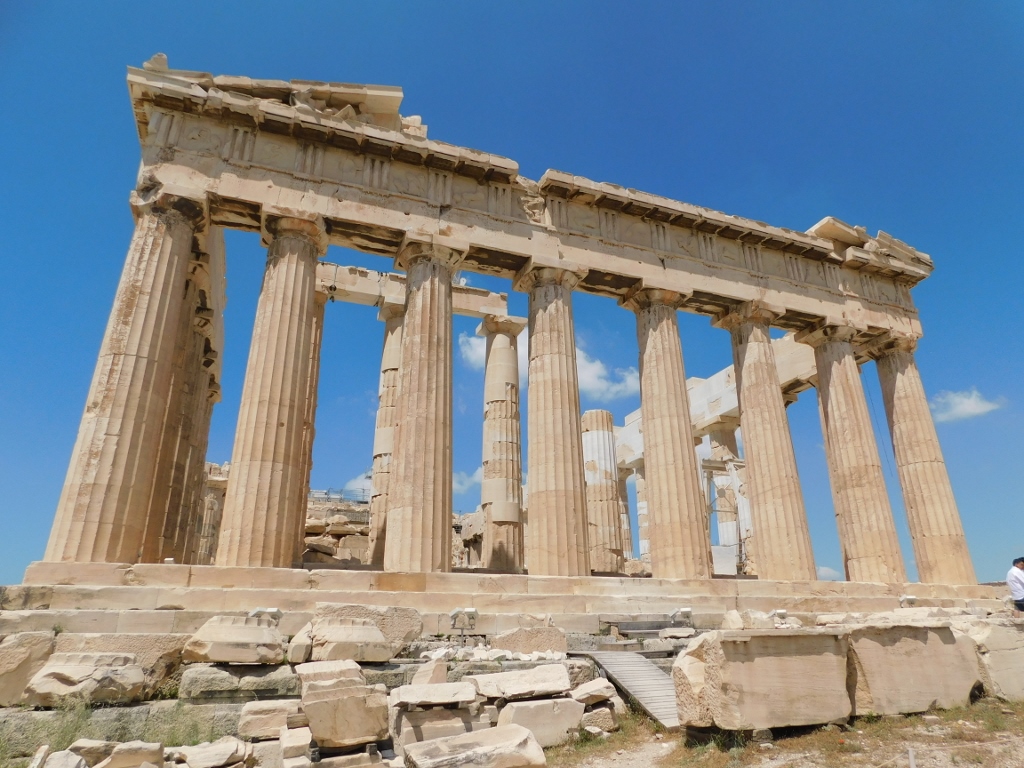 Parthenon, the east side
Parthenon, the east side
So, the Parthenon has a rectangular ground plan, it was made of marble and it was placed on a marble stepped platform. At the level of the top step of the platform, its dimensions are 69.5 x 30.9 m, while its height is 13.72 m. It is surrounded by 46 Doric columns, 8 each on the front and the back sides and 17 each along the flanks.
Above the columns there is an architrave and above it a Doric frieze within which there is alternation of triglyphs and metopas. Let me clarify: architrave is a beam that is put on top of columns and that connects them. Frieze is a wide section of the main cornice and it serves as a decorative ribbon. Triglyphs are fields with three vertical channels and between them are metopas, fields which in the case of the Parthenon were decorated by high relief showing various mythical and historical scenes and characters. Several metopas have remained in situ, but for different reasons they have been damaged to a large degree. Some have been moved to the Acropolis Museum, some to the British Museum and one is at the Louvre.
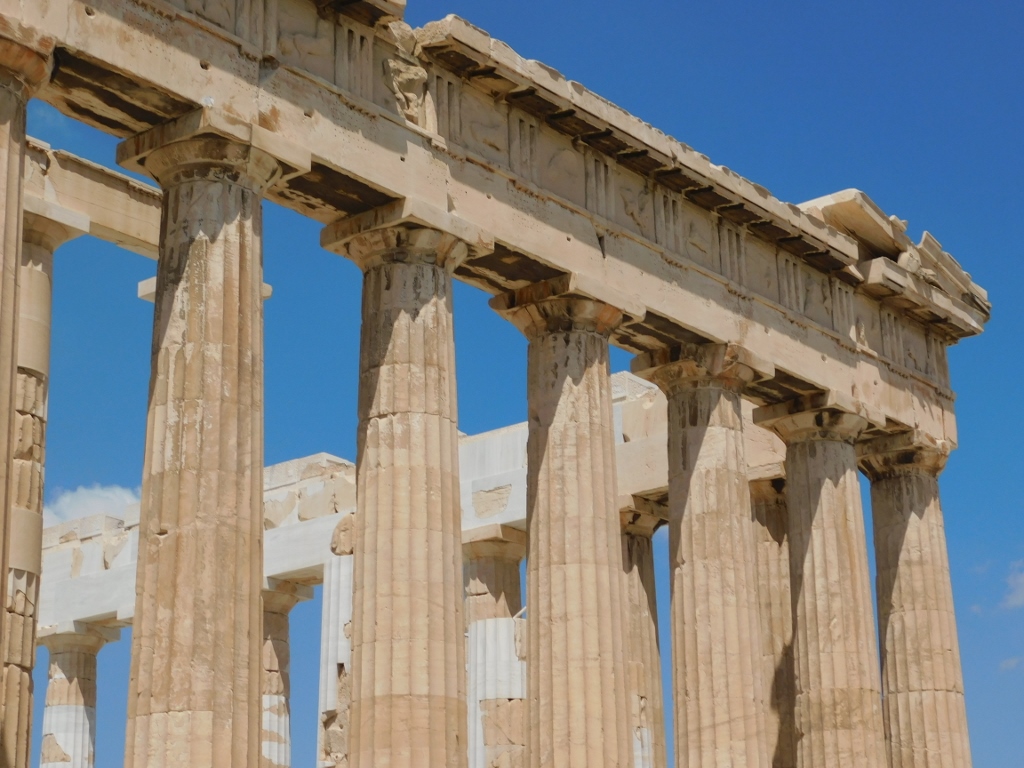 Parthenon, a detail
Parthenon, a detail
By the way, here I have to mention briefly my wonderful history of art teacher from the 3rd grade of high school who talked to us about these things with so much love and enthusiasm that I remember them even today, albeit in general terms.
On both of the narrower sides of the temple, above the cornice and as a part of the roof structure, there used to be triangular pediments decorated by statutes. One of them can be seen within the remains of the east pediment.
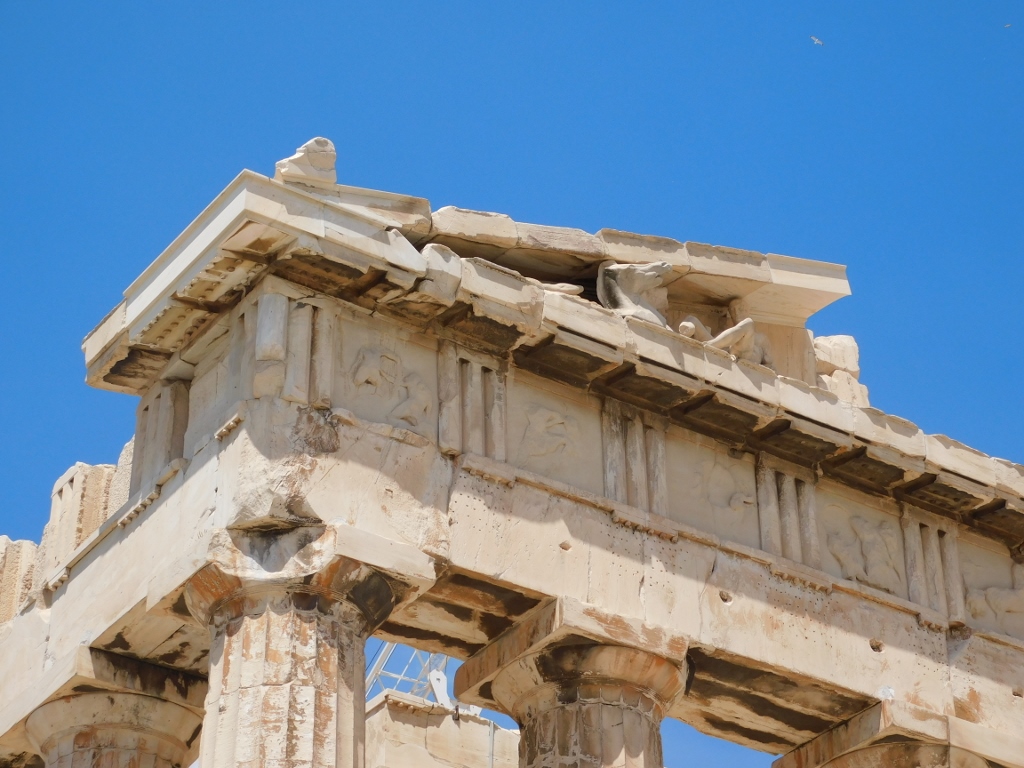 Parthenon, a detail
Parthenon, a detail
In the interior of the temple there used to be a few rooms separated by walls and doors, and there was a myriad of Ionic columns that carried the ceiling of the temple and served as decoration. In the central shrine, the naos, there was Phidias’s sculpture of goddess Athena that was made of wood structure and covered in ivory and gold. The sculpture was around 11.5 m tall.
Along the exterior walls of the naos there was an Ionic frieze (an uninterrupted sequence of sculptural reliefs). By the way, although with its whitish marble the Parthenon is seen as the exemplar of elegance, the original was in fact very opulently painted, including all of those reliefs. Out of 160 m of this frieze, 128 m have survived to date. By far the biggest part of this frieze is at the British Museum. These segments of the frieze ended up there because the British, or to be more precise a British lord with subsequent complicity of the British government and state, at the beginning of the 19th century, when Greece was under the Ottoman rule, simply took not only this frieze, but also numerous other parts both of the Parthenon and other holy structures at the Acropolis and transferred them to London. To this very day, the UK and Greece have been negotiating about the return of these priceless artefacts to where and to whom they actually belong.
Here is what I think about it. Today, the USA is more powerful than the UK and everybody is talking about the climate change. Let’s imagine that the Americans come to England and simply take Stonehenge only because it is where it is, in the open fields near Salisbury, exposed to the dire effects of the global warming and transfer it, let’s say, to the Metropolitan Museum. I believe that, to put it mildly, the British would not be amused.
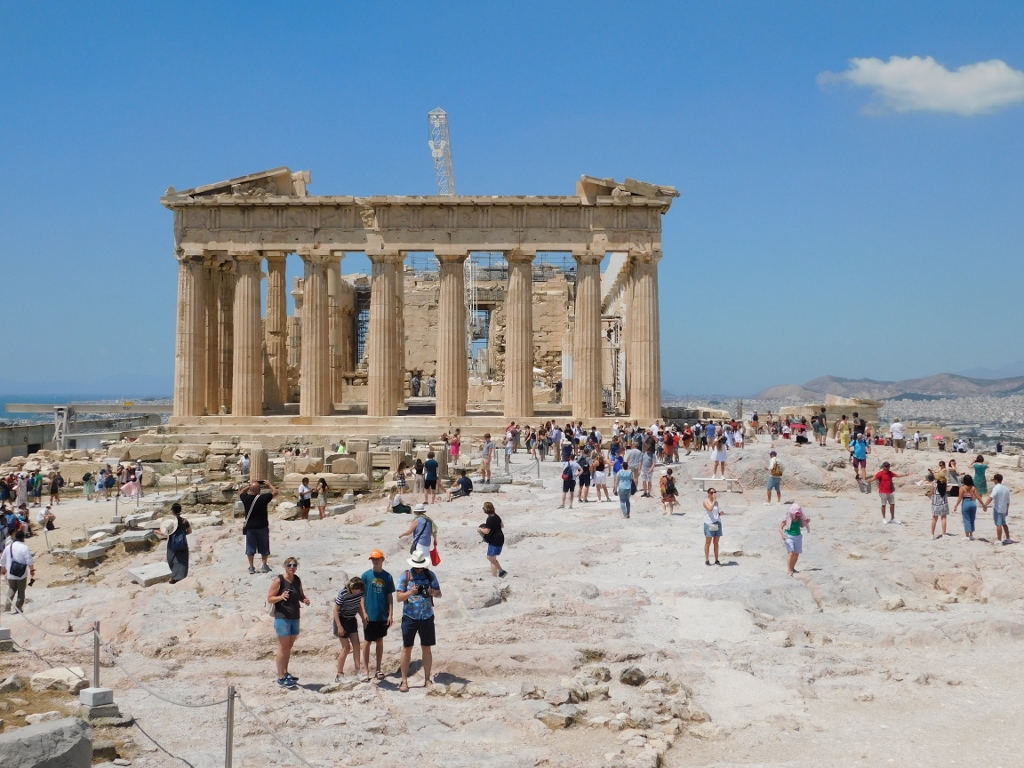 Parthenon, the east side
Parthenon, the east side
Today, there is only a “shell” of the Parthenon left. In addition to the effect of the passing time, numerous individuals have been ripping off pieces of the temple for centuries, sometimes successfully, sometimes not – up to the level of total destruction. The biggest damage to the structure itself was made in the second half of the 17th century when within the scope of a war the Venetians came here in order to take over Athens from the Ottomans. The Turks withdrew to the Acropolis and stored a gunpowder magazine in the Parthenon. On 26 September 1687, with a single canon shot, the Venetians hit this area, there was an explosion and a significant part of the temple, including also sections of the naos and the roof, were destroyed.
With my visit, I came now to the east part of the Acropolis where there is a viewpoint. In addition to the lovely view at the top of the Acropolis and Parthenon, one can also see very nicely the north areas of Athens.
 Parthenon, Acropolis and Athens
Parthenon, Acropolis and Athens
 North parts of Athens
North parts of Athens
By the way, on the top of the rocky hillock where the Acropolis is located, in addition to the rock base and remains of several major and important structures that are still standing, one can also see a whole lot of smaller segments of former structures. Namely, in addition to these few temples the remains of which can be seen nowadays, there were around six other temples and sanctuaries at the Acropolis, as well as numerous statues.
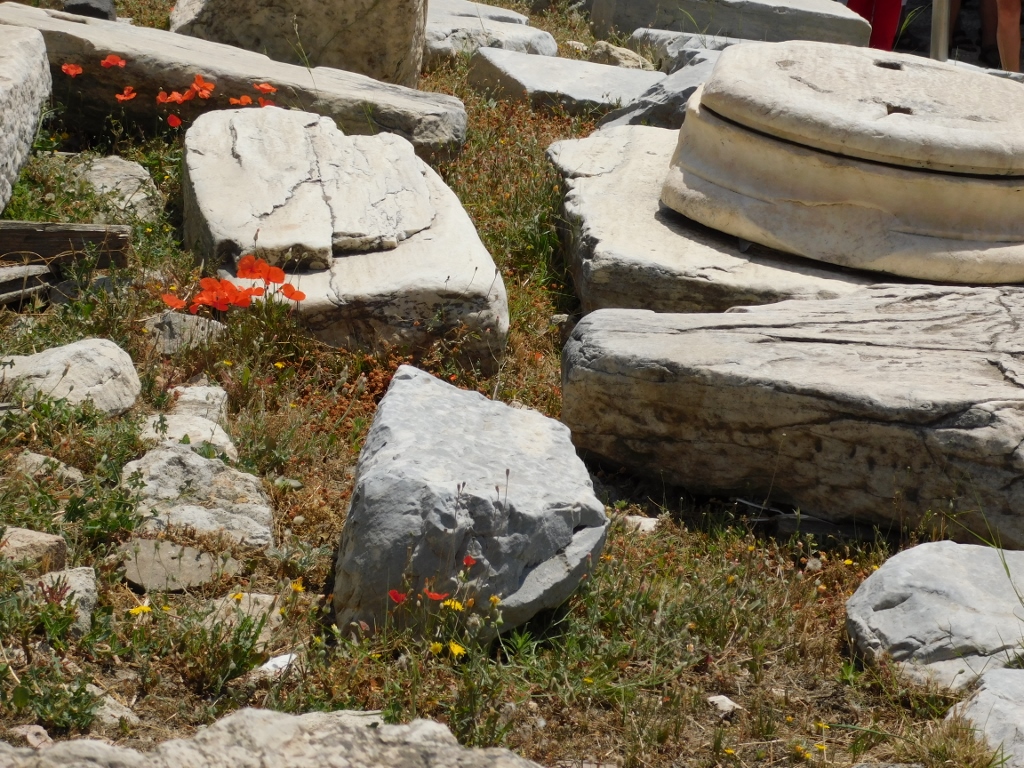 Acropolis, a detail
Acropolis, a detail
I was very content with my visit and there was only a selfie left to make before heading to the last important temple of the Acropolis.
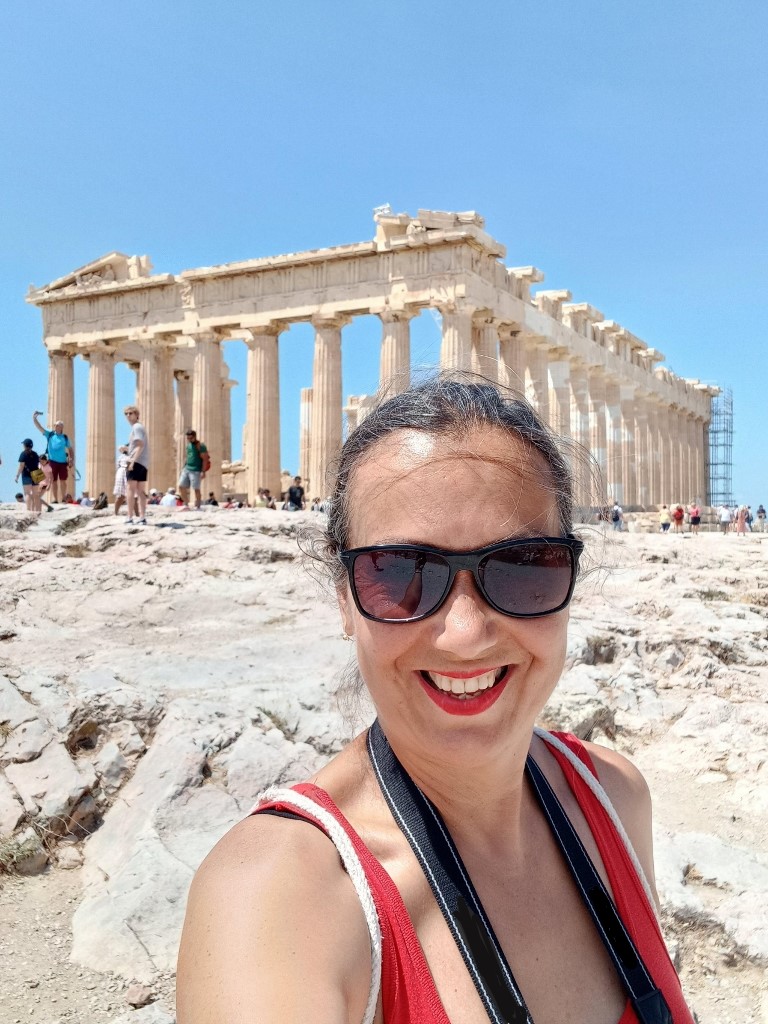 Selfie at the Acropolis
Selfie at the Acropolis
I’m talking about the Erechtheion which basically has a rectangular ground plan, but the two porches that protrude, in the north and south, “spoil” this regular shape. The reason for such ground plan lies in the configuration of the terrain and the need to bring together two ancient points within a single temple.
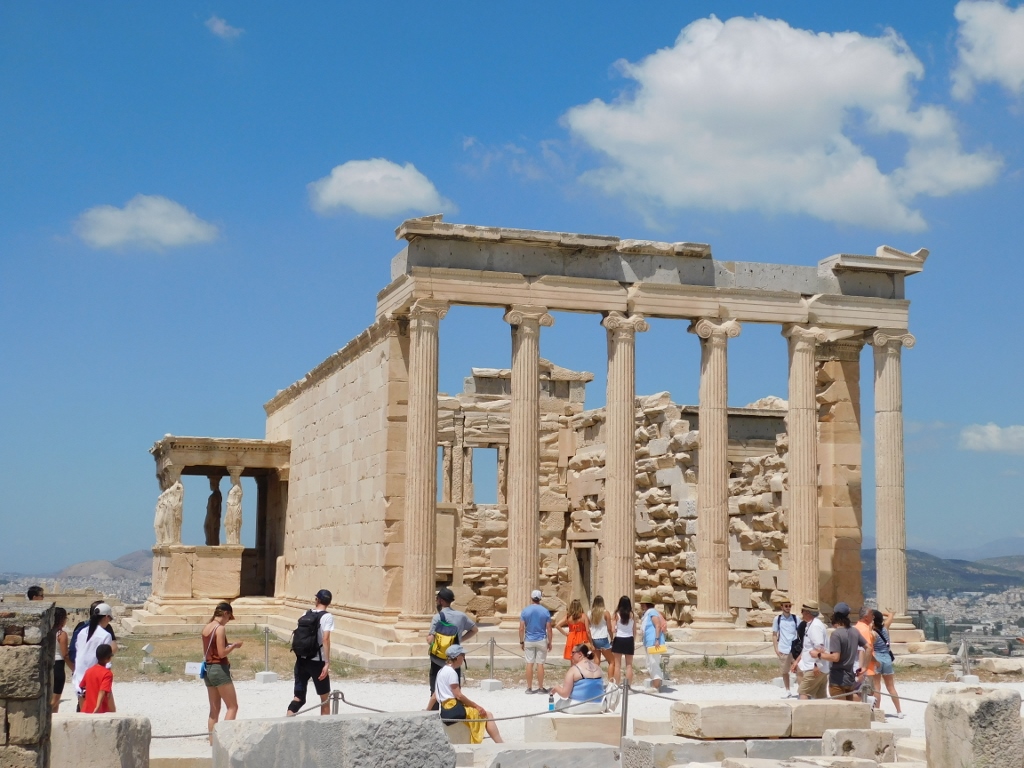 Erechtheion, approach from the east side
Erechtheion, approach from the east side
From a clearing by the southeast corner of the temple, it is possible to see the Propylaia, primarily thanks to the fact that an ancient temple dedicated to Athena that used to stand in this place disappeared completely over time and today it is possible to see only the rocky remains at the level of the base.
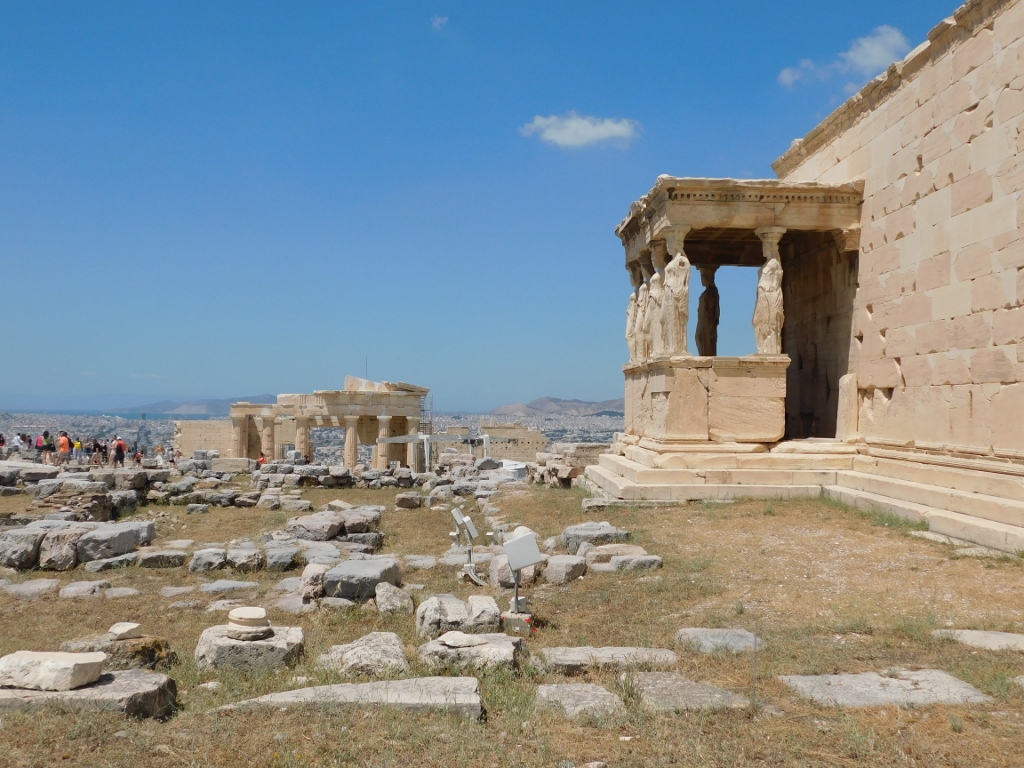 Erechtheion to the right and the Propylaia to the left
Erechtheion to the right and the Propylaia to the left
From here, the visitor can also see one of the specificities of the Erechtheion and that is the famous south porch the roof of which is carried not by columns, but by caryatids. A little more about them later on.
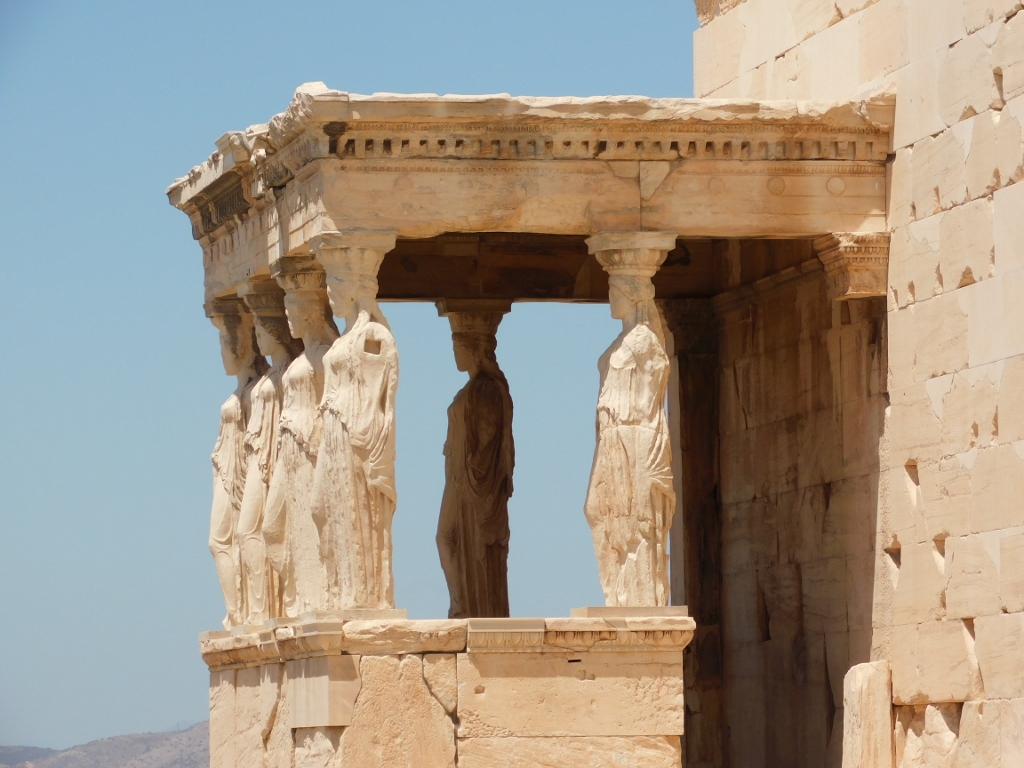 Erechtheion, a detail
Erechtheion, a detail
Now I started to circle around the temple, the naos of which was divided by a wall into two segments. The east, front one was dedicated to goddess Athena Polias, the protectress of the city. The west segment, the level of the floor of which, because of the slope, is 3 m below the east one (although their roof was at the same level) was dedicated (or at least its main section) to the mythical king of Athens, Erechtheus, who is in some of his aspects linked to the god of sea, Poseidon. This west segment was entered via the north porch.
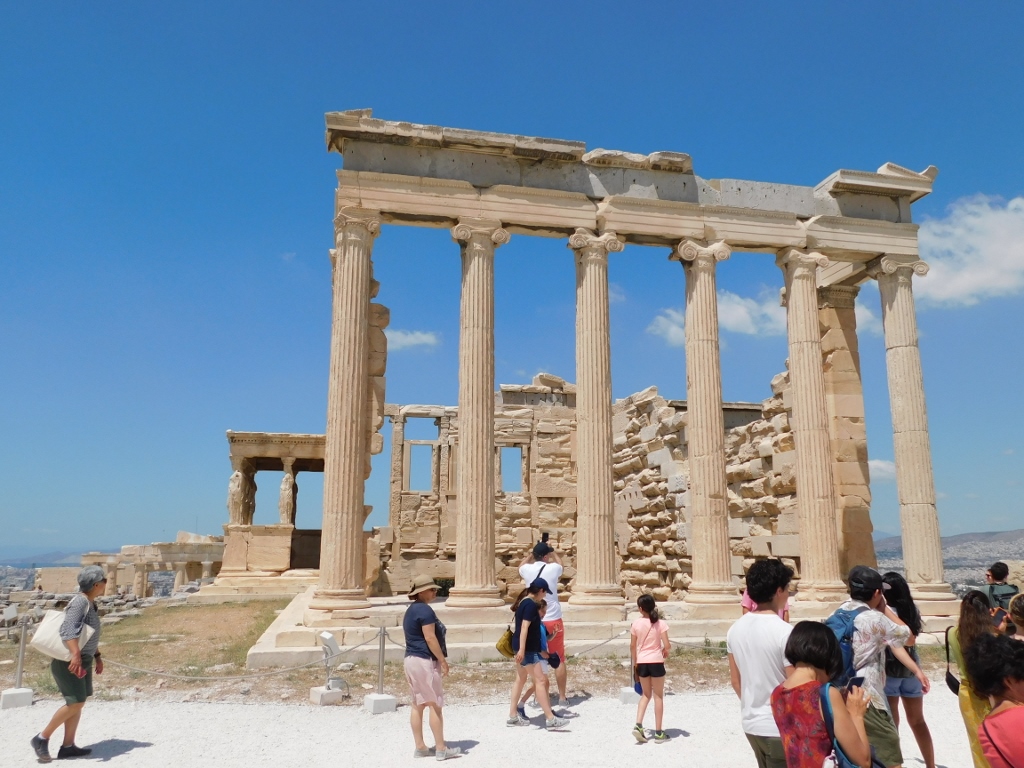 Erechtheion, the east side
Erechtheion, the east side
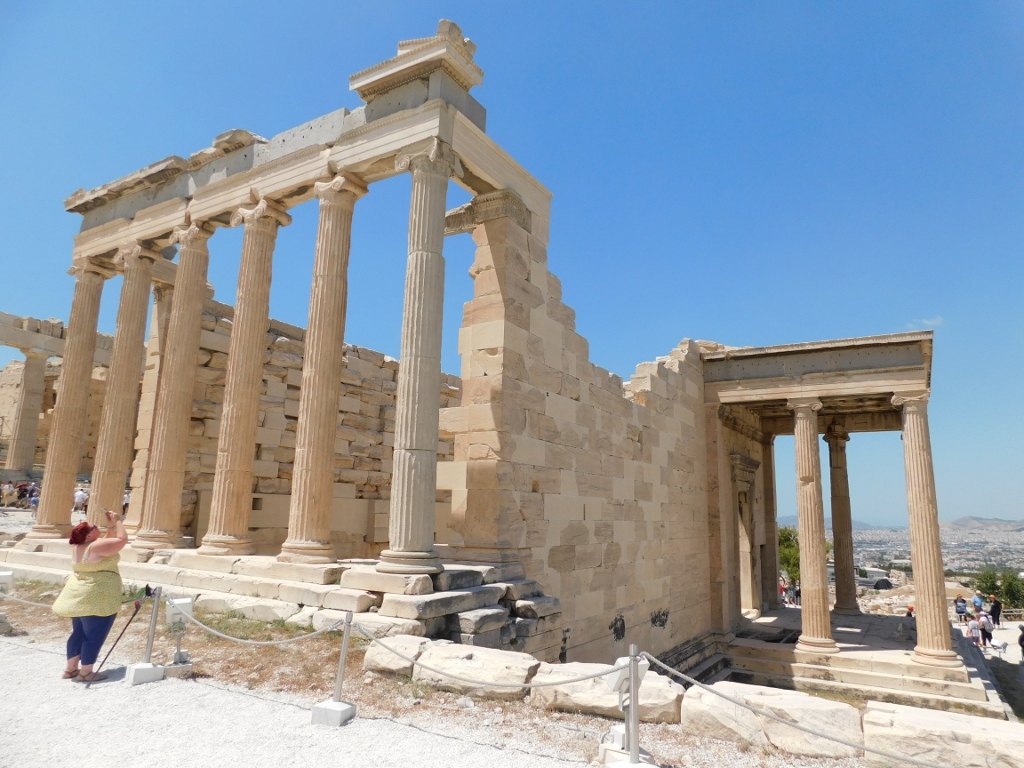 Erechtheion, the northeast corner and the north porch
Erechtheion, the northeast corner and the north porch
The north porch is adorned by six magnificent Ionic columns and there is also an impressive doorway, as well as a splendid ceiling that used to be painted back in the day.
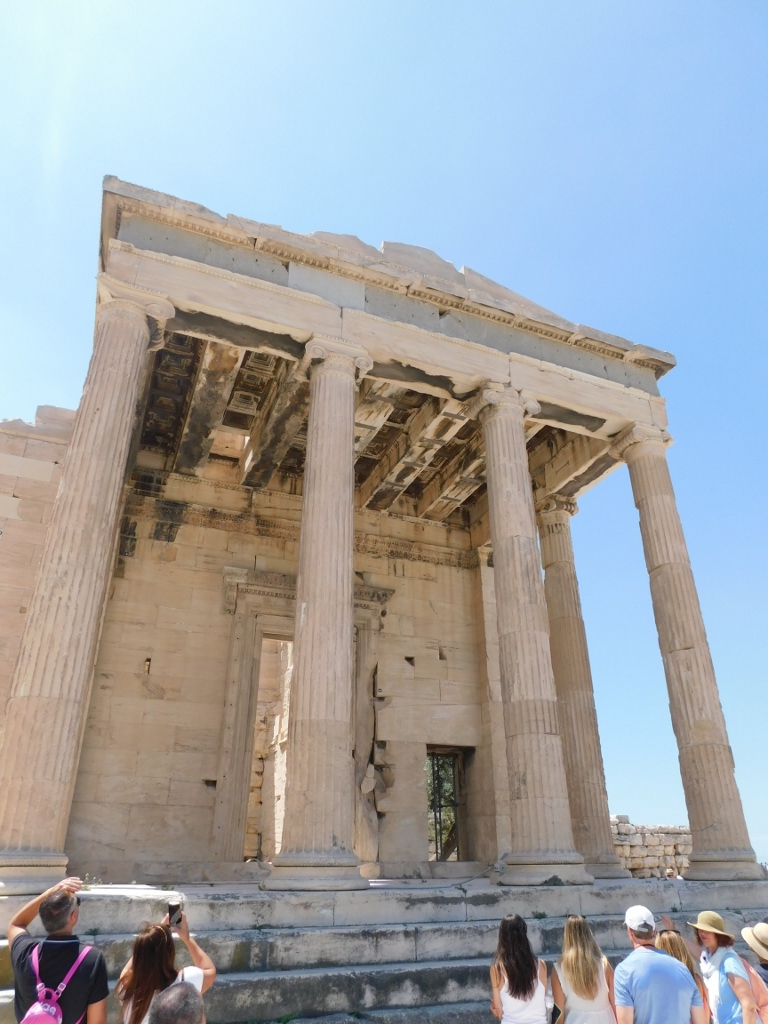 Erechtheion, the north porch
Erechtheion, the north porch
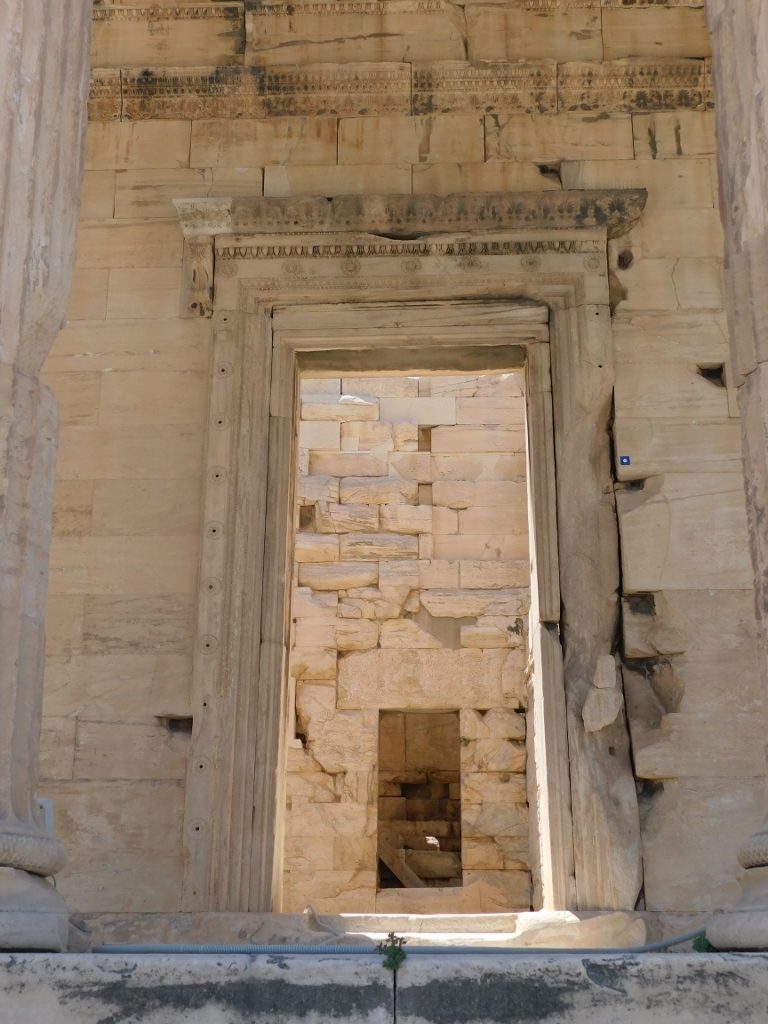 Erechtheion, the north porch, a detail
Erechtheion, the north porch, a detail
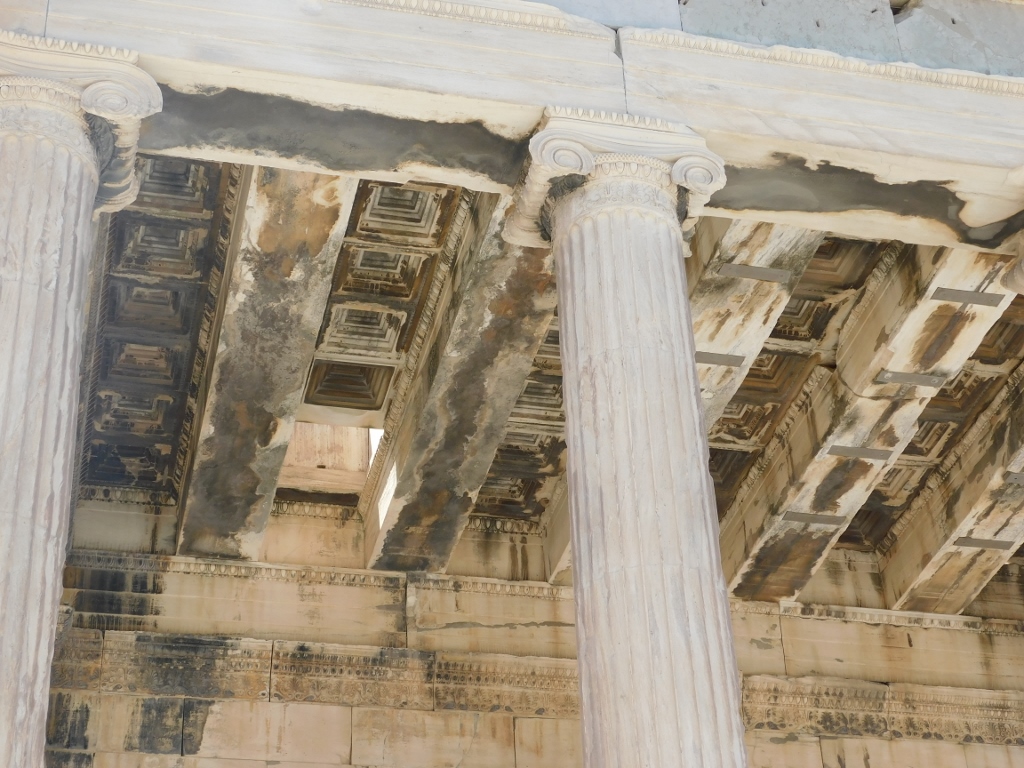 Erechtheion, the north porch, a detail
Erechtheion, the north porch, a detail
But, what makes the Erechtheion recognisable is its south porch and the caryatids. The porch is often called the Porch of Maidens and you can see six statues of young women that are 1.77 m tall.
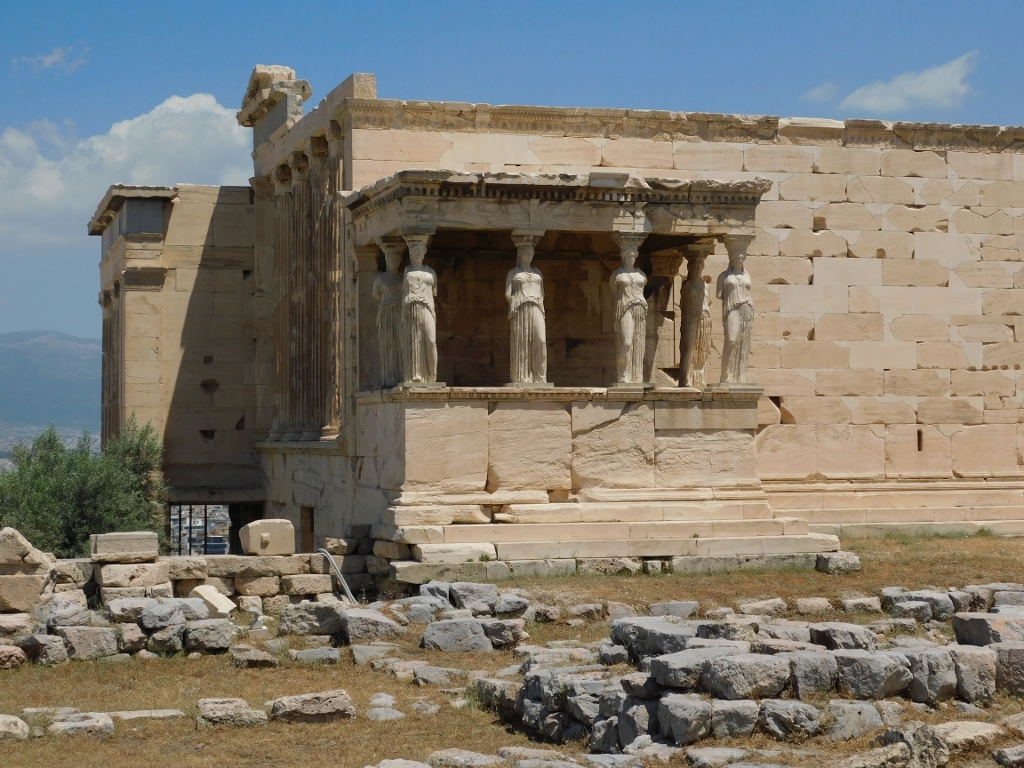 Erechtheion, the south porch
Erechtheion, the south porch
The three girls on the west side step out with their left legs, while the three girls on the east side step out with their right legs. By the way, that British thief that had the title of an earl also stole one of the caryatids (the third from the left) and took it back to London together with the northeast column at the corner of the temple. Over time, the Greeks have made its copy and they also made copies of the remaining caryatids. Then they replaced the originals that are nowadays at the Acropolis Museum with the exception, of course, of that one which the British still refuse to return to the legitimate owners.
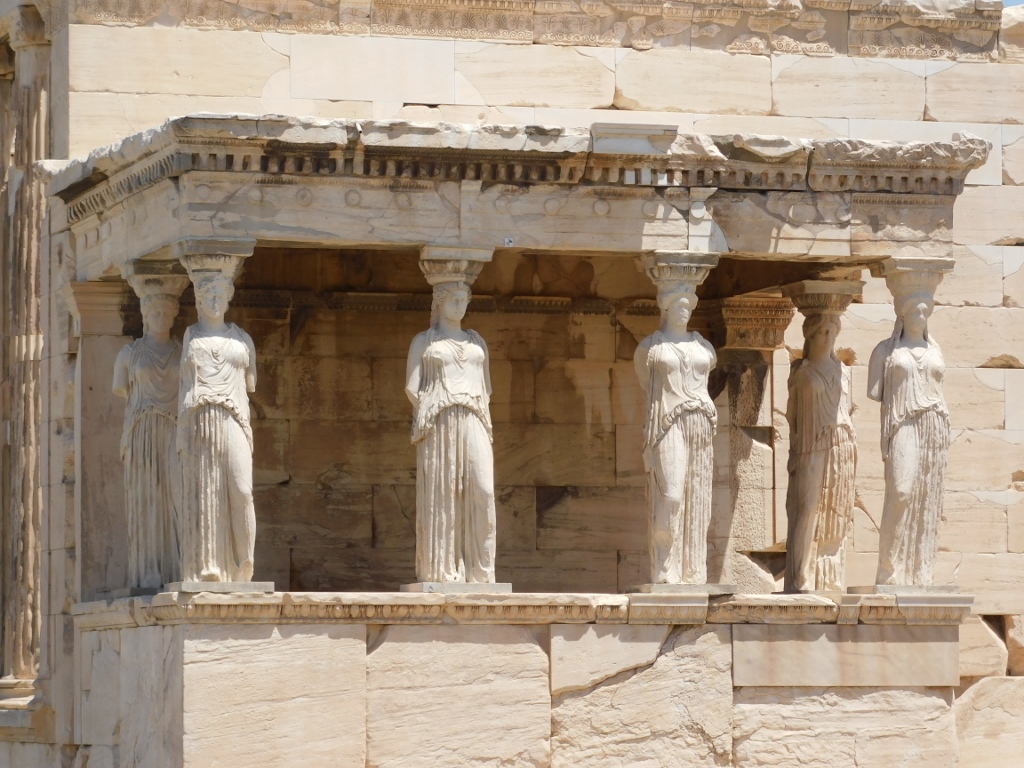 Erechtheion, the south porch, a detail
Erechtheion, the south porch, a detail
Now I headed slowly back towards the exit, but I still had to look back once again at the Erechtheion.
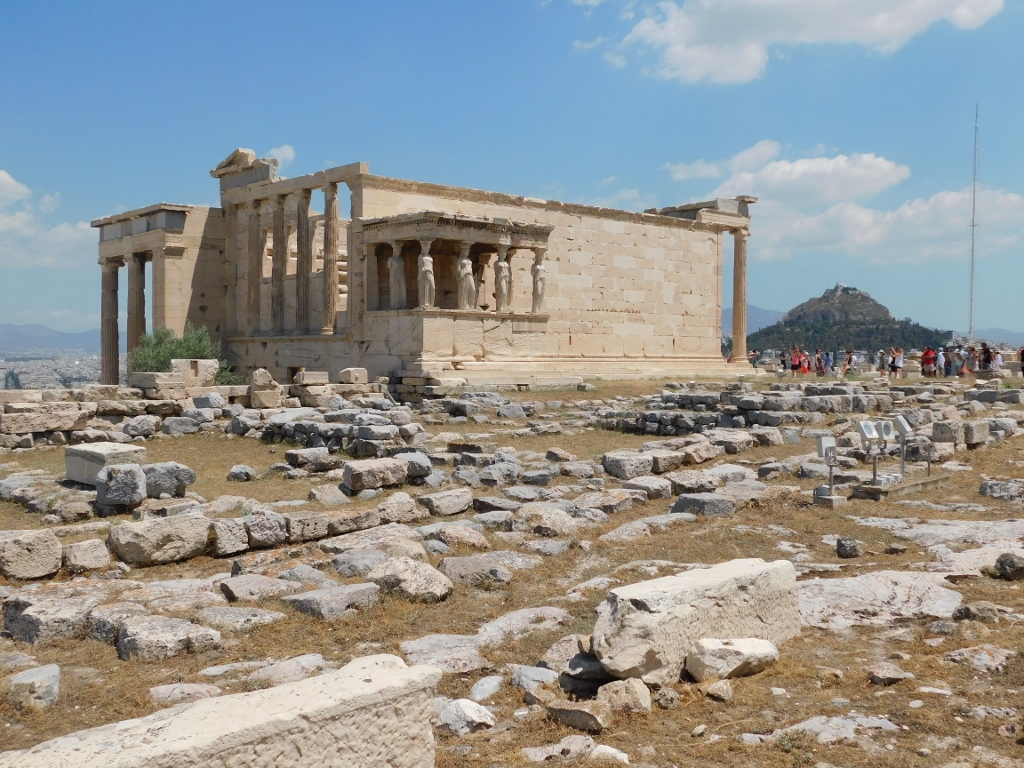 Erechtheion and the remains of a temple dedicated to Athena
Erechtheion and the remains of a temple dedicated to Athena
Having finished with my visit to the Acropolis, I started to return towards the hotel since I had an afternoon flight to Belgrade and this did not leave me with too much free time. I decided to go on foot again. It took me more than half an hour, but I knew the way. I’m sure one can move around Athens by public transportation, but I did not have the time to study the routes of different bus and/or underground lines.
On my return stroll, I walked a part of the way through the National Garden near the Zappeion Hall, which was somewhat longer, but there was more shade. As it turned out, however, I stumbled across yet another “bonus” here and that was in the shape of – parrots!
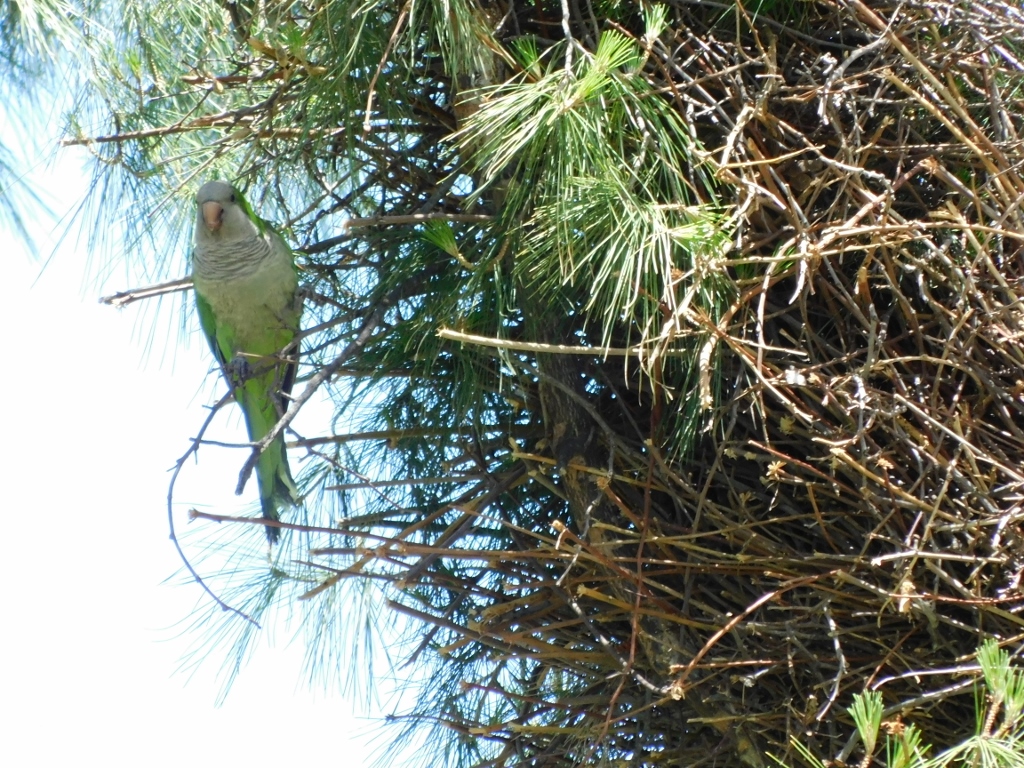 Parrot in Athens
Parrot in Athens
I was quite surprised because parrots do not live naturally in the Balkans, but later I found out that this was in fact monk parakeet (Myiopsitta monachus). This species naturally inhabits subtropical parts of Argentina and the surrounding countries, but has become very popular as a pet and has thus been exported to the other parts of the world. Then it happened that individual birds were either released or they escaped and so in the areas where the climate was suitable they started to live as feral birds. In this way the monk parakeets have become an invasive species in the USA and parts of Europe.
Here in Athens, in the National Garden near the Zappeion Hall, the monk parakeets make large nests in the treetops.
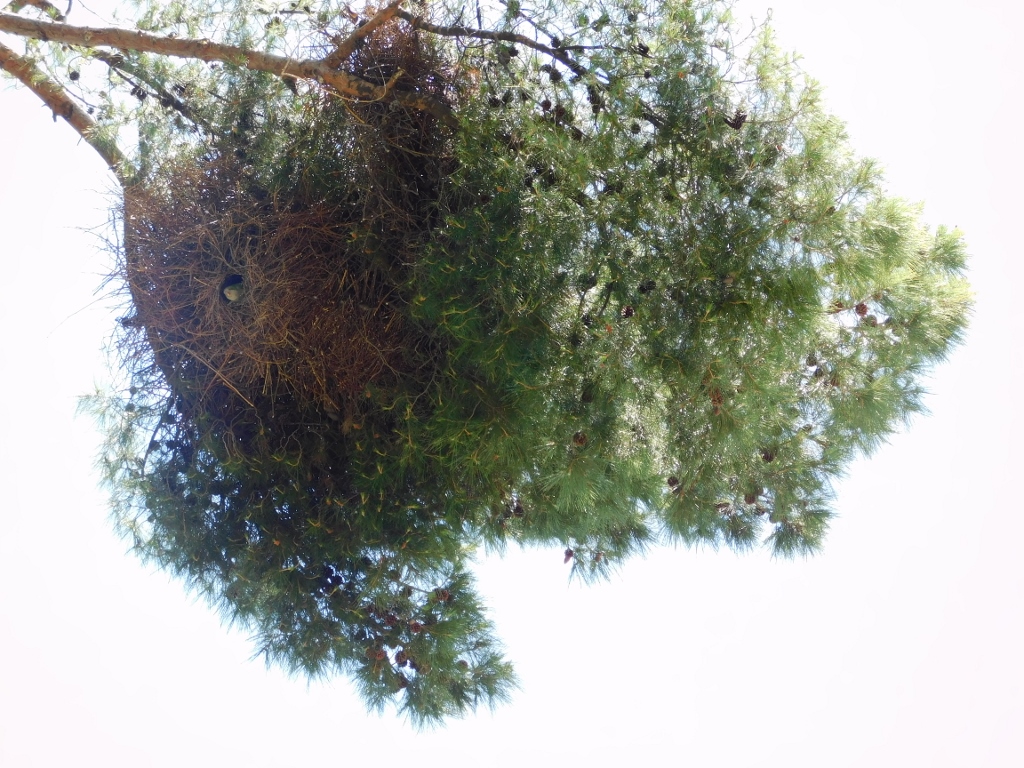 Monk parakeet’s nest
Monk parakeet’s nest
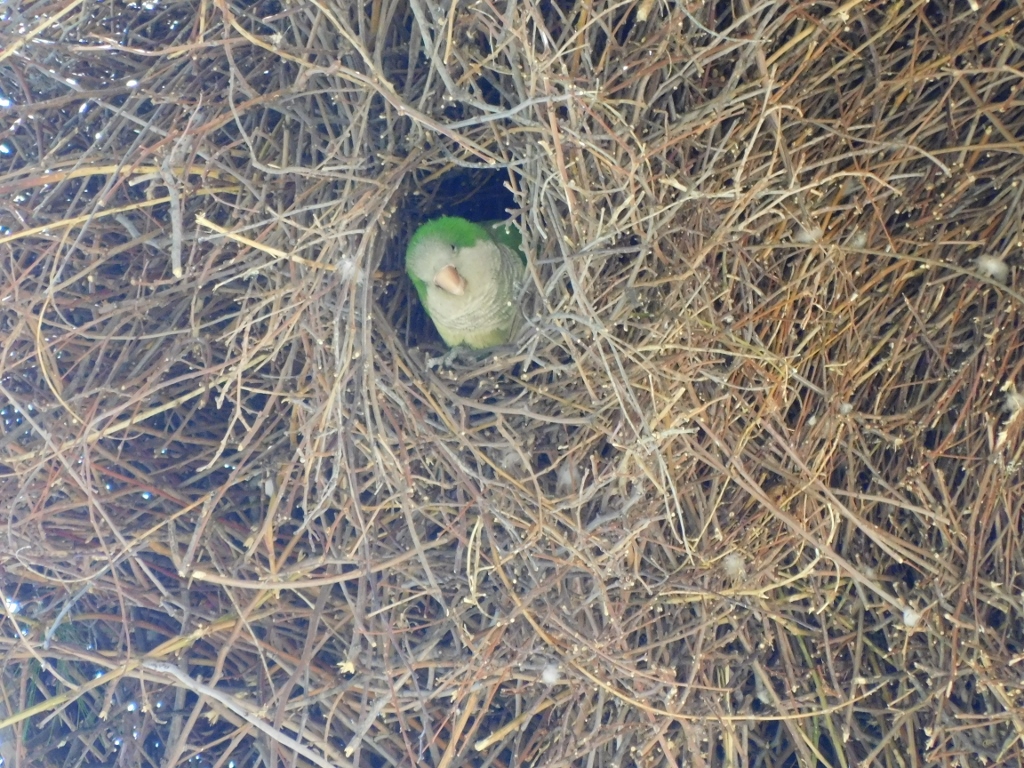 “Let’s see who’s looking at us...”
“Let’s see who’s looking at us...”
I would have gladly stayed here to watch the parakeets, but I did have to go back to the hotel. After leaving the park, I walked along some streets, trying to choose those that had less traffic in order to avoid the traffic noise, but I also attempted to walk in shade. I reached the hotel right in time to be able to treat myself to a nice, cold, local beer, as a parting from Athens and Greece.
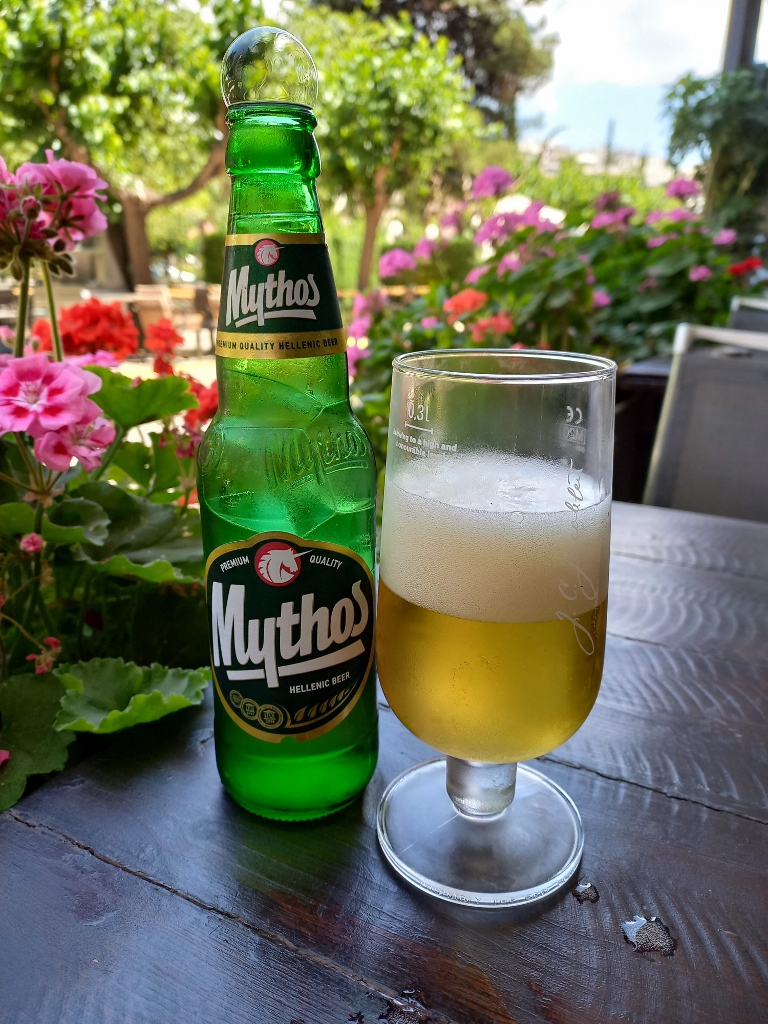 Beer in Athens
Beer in Athens
The previous evening I had agreed with the taxi driver who brought me from the airport to take me back there as well and he was very punctual, as was I. There were some problems at the airport again, because the girl at the check-in desk could not find me in the list of the passengers, but after some 15 minutes of verifications, I finally received my boarding pass.
Everything else went as it should and now I can finally close this story about the absolutely fabulous travel around Crete, with an unexpected and unplanned bonus – a visit to the Acropolis of Athens.